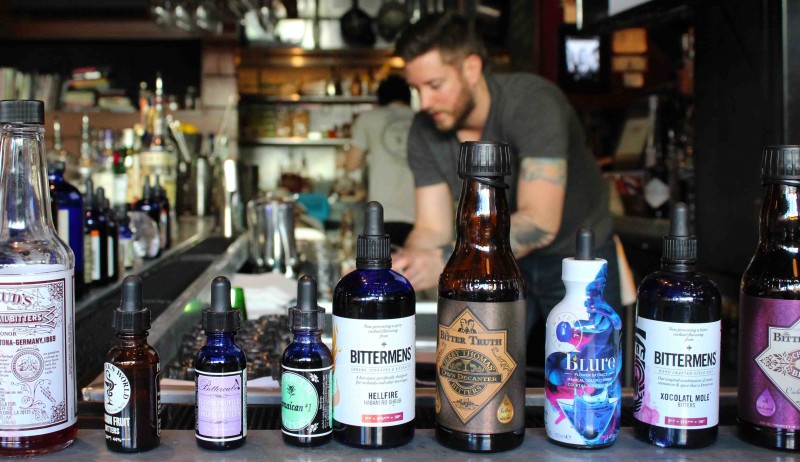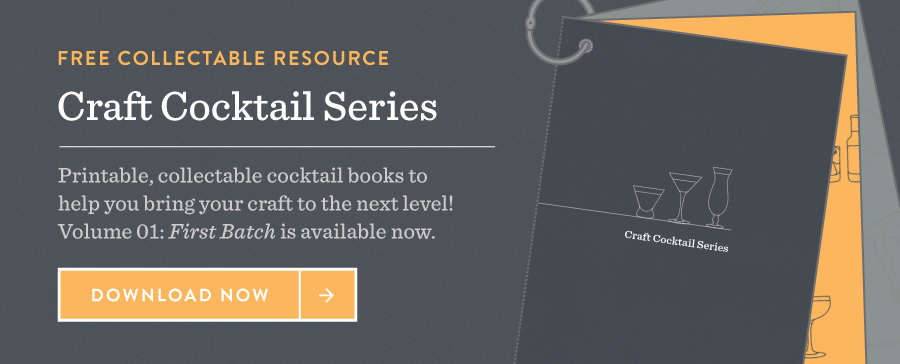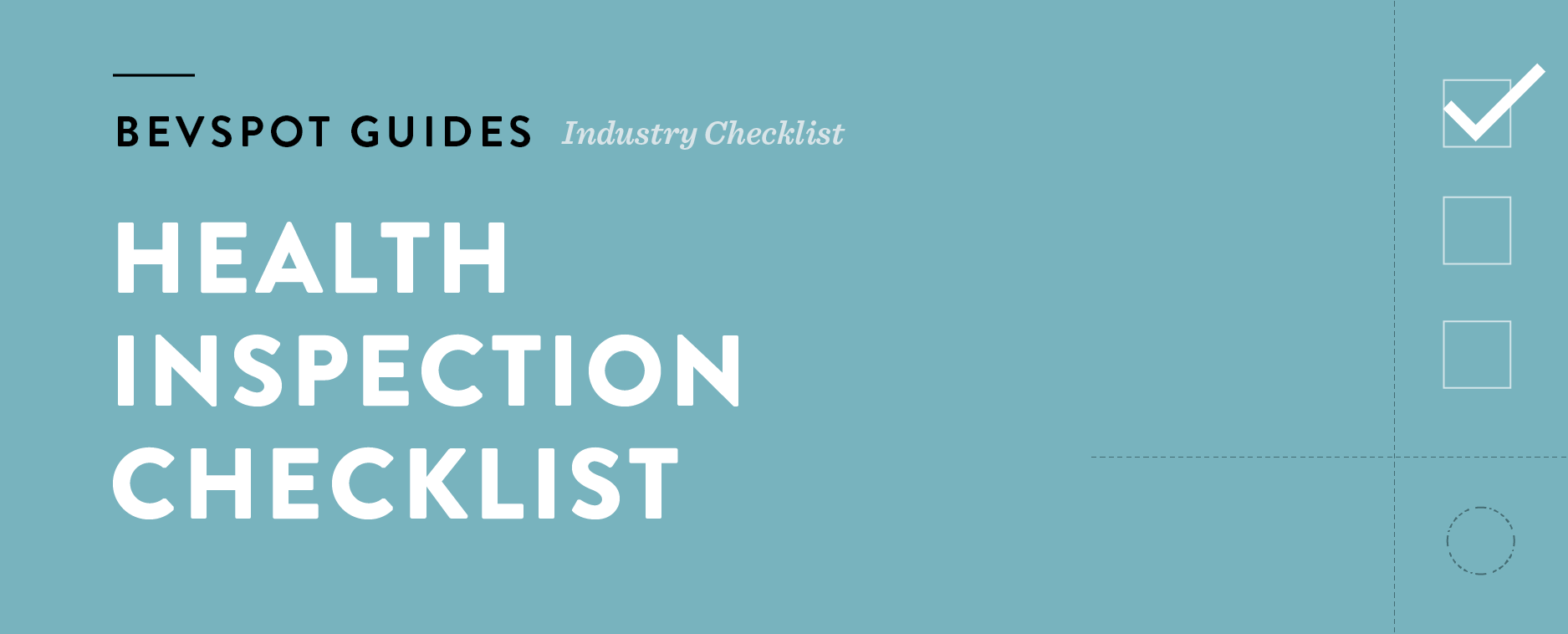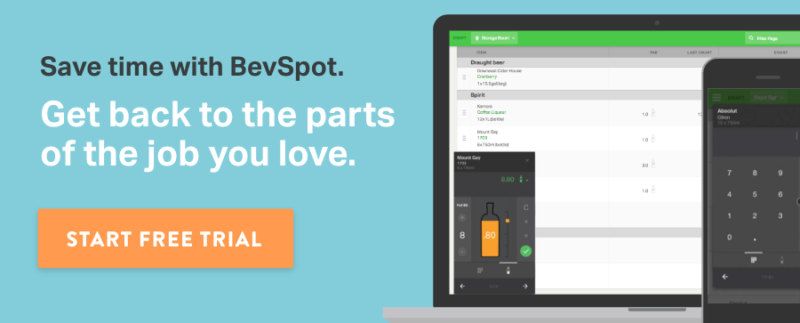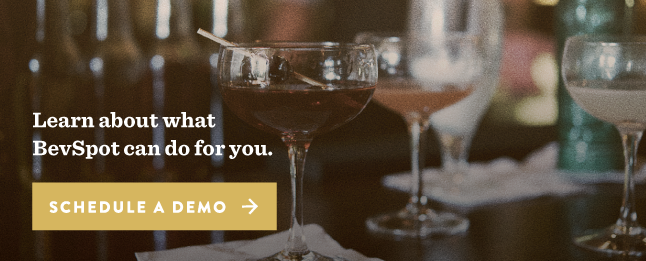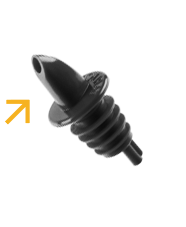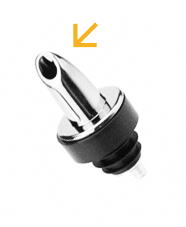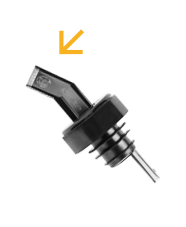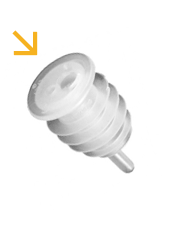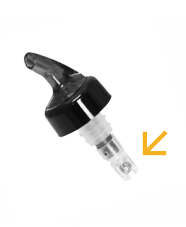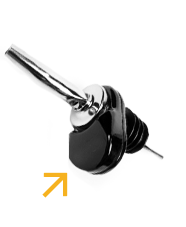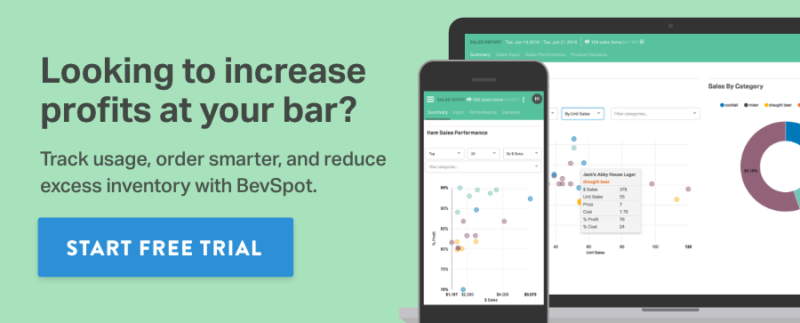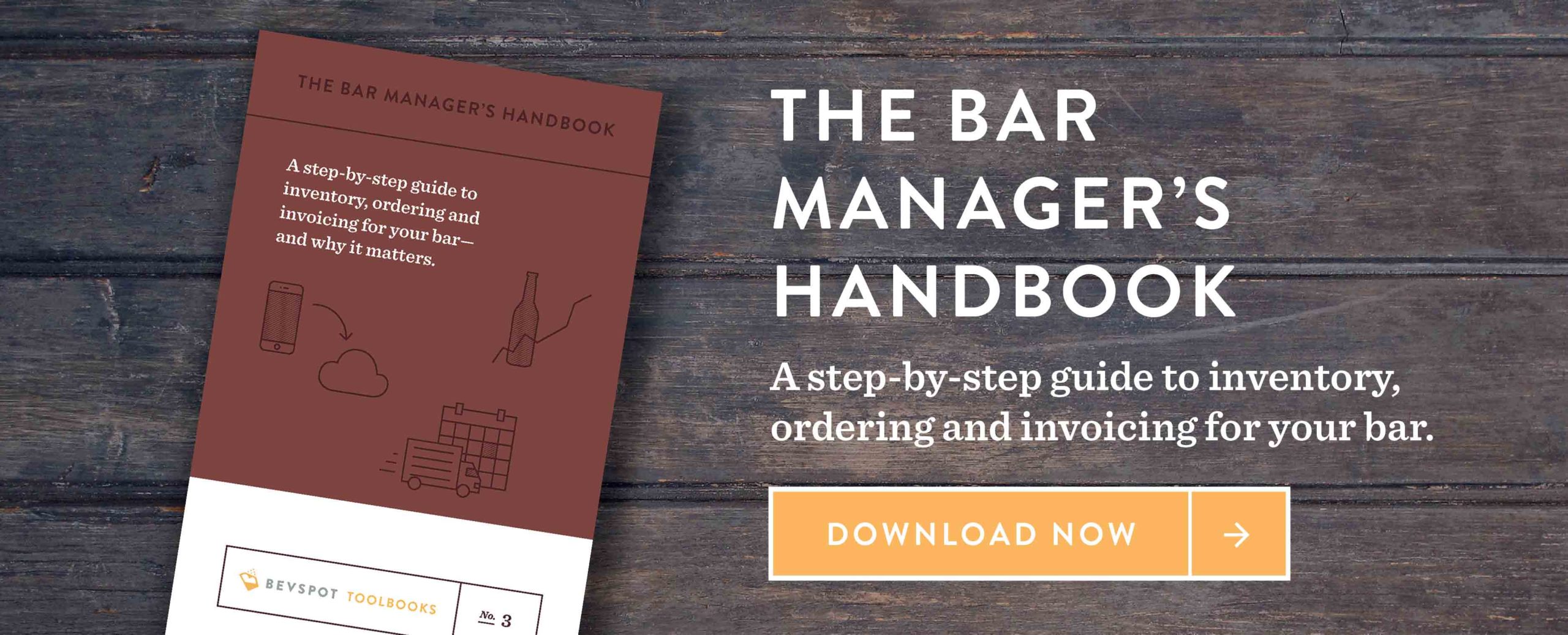What’s the Secret to the Perfect Cocktail?
How to Make the Perfect Cocktail
“We don’t like to be called mixologists,” says Scott. “I’m generalizing, but those who call themselves ‘mixologists’ often take themselves too seriously.” Scott Baird and Josh Harris are the founders of The Bon Vivants, nationally recognized experts of everything bar, mixology, and hospitality. Along with branding, design, and flavor consulting, they define thoughtful and sophisticated perfect cocktail programs for bars all over the country.
We recently sat down with Scott and Josh at the Charleston Wine and Food Festival. Over several cocktails at a local bar called Proof, they discussed the art of mixology and the key to crafting the perfect cocktail.
The most important rule of mixology, the rule that supersedes everything else, is that balance is everything. “All flavors are completely irrelevant if a drink is out of balance,” says Scott.
Typically, flavors that are going to make a drink either in or out of balance are:
- Acidity
- Sweetness
- Bitterness
- Booze
“The core principle we’re always trying to strive for when we create cocktails is balance of these elements,” says Josh. That can come in three ingredients, or it can come in 20, but if a drink isn’t balanced, it’s not going to taste good.
“If you don’t enjoy a drink, it’s not the fault of your taste preferences; the flavor profile is probably out of whack,” he adds.
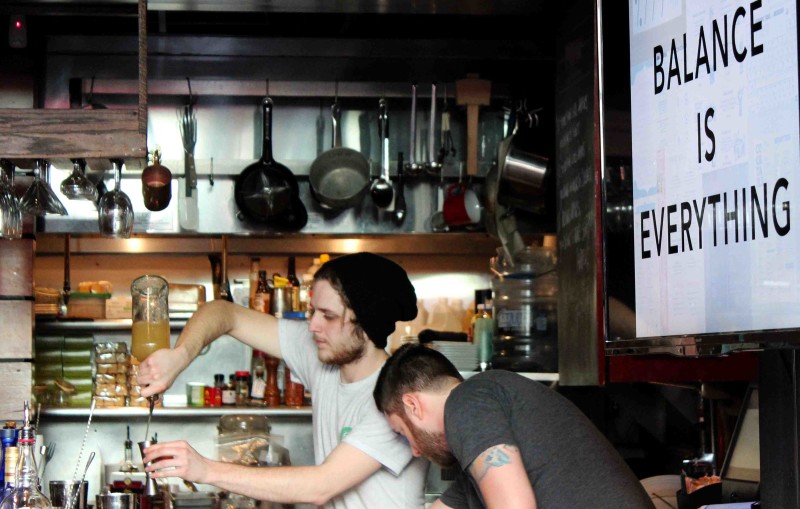
Mixology legend, Jerry Thomas, first taught us the definition of a cocktail—a combination of spirit, sugar, and bitters. Cocktails were created as a method of disguising poorly made spirits, like a horrific blend of gin made in a bathtub during prohibition.
However, the fourth ingredient people don’t often mention is water. By adding ice and shaking, you’re adding an ingredient. “When you shake a cocktail, you’re adding over an ounce of water. The same goes for putting drinks on the rocks—more water is added over the course of the time it takes to drink it,” Josh explains.
The Mind of a Mixologist
For Scott, mixing a cocktail is the same as cooking a piece of meat—add salt and it’ll be delicious, but if you rub it with chili oil and finish it with fresh lemon and salted onions on the side, it’s even better. “You’re layering flavor and enhancing the core ingredient.”
As with all good chefs, mixologists approach their product with complexity, but quickly realize that scaling it back to something simple usually tastes better. We’ve seen this retreat to more simple, classic drinks trending in bars all over the world. “People have gotten all that crazy out of their system. They’ve experienced it and they know a drink’s potential, and now it’s a tool they have; bartenders are more educated by virtue of their experience now that they’ve played with the flavors.”
“When I think of flavors,” says Scott, “I almost see them in colors, or think of them as masculine and feminine or treble and bass. The ultimate goal is to hit all the notes.”
Scott and Josh describe the tasting process of a great drink. “First, you taste the sweet and then you get some of the tart, and there’s savory in there and then the bitter comes along, and it’s a little dry and it leaves you wanting more. You just took this flavor ride. And it was fun. And it ended. But you can make it happen again.”
This is how The Bon Vivants envision cocktail development. Does a drink leave you wanting more? Is it highly craveable? “We don’t put drinks on our menu that we wouldn’t have at least two of,” Josh says.
He describes one of the first (and most controversial) drinks on their opening menu at Trick Dog, in San Francisco—a modernized Whiskey Sour. It was a combination of bourbon, combier, kummel, beet, ginger, and lemon. “Scott just barfed out a list of ingredients,” Josh remembers the conversation…
“It’ll taste delicious.”
“I don’t doubt that, but no one’s going to order it, and if you put it with bourbon we’re going to lose one of our bourbon drinks.”
And so they argued, but it eventually ended up on the menu.
In their first six months they sold 9,000.
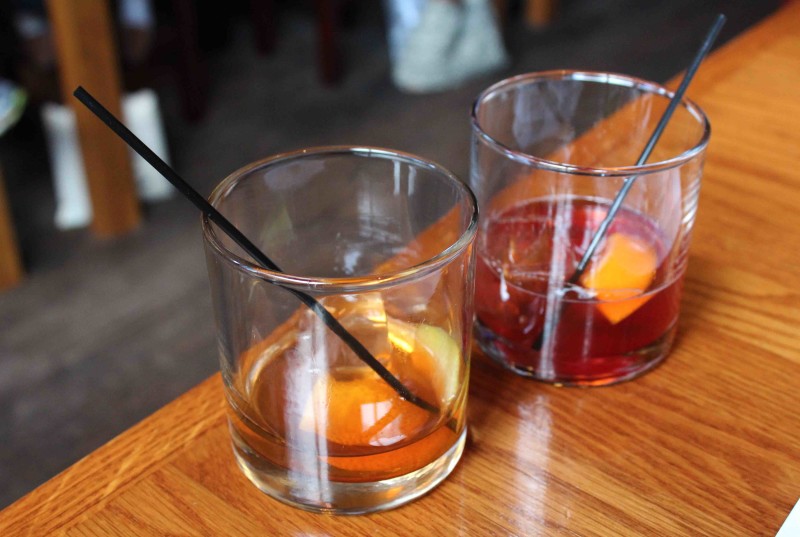
Craig Nelson, owner of Proof, in Charleston, took inspiration from his southern grandparents to create one of Proof’s award-winning cocktails—The Knuckleball. It’s essentially a Manhattan, but it tastes completely different.
“We developed a Mexican Coca-Cola reduction, which comes out with an amaro or vermouth-style quality. We add bourbon, a splash of orange bitters, and—because the drink is a little on the sweet side—we pickle some peanuts and add a hot pickle brine.” The bourbon and bitters are followed by the rich flavor of peanut. It’s perfectly sweet and perfectly tart; it’s balanced.
There are some obvious steps to understanding what’s in balance and what’s not. “Either there’s too much of something or not enough of something, and if you ask yourself those questions, you’ll usually know what it is,” says Josh. As bartenders, we like to think all our drinks are balanced, but within that zone of balance there are going to be preferences that are slightly sweeter or slightly dryer.
Scott explains the difference between New York and San Francisco bartenders. “Generally, New Yorkers make more bitter and sweet drinks, and San Franciscans are known for mixing more dry and tart drinks.” New Yorkers supposedly pay more attention to the classics, which tend to have a little more viscosity and mouthfeel due to products like Chartreuse and Carpano Antica. In California, there’s an abundance of fresh produce and citrus, so their style comes from what’s referred to as the “California cocktail renaissance,” which was originally described as “the market-fresh cocktail.”
“We definitely see two distinct styles,” says Scott. “That’s not to say one is better than the other; they’re just different.”
The 4 Key Ingredients of a Perfect Cocktail
Josh and Scott detail their four most important mixology ingredients to have in your bar inventory. “Any cocktail bar that fancies itself a cocktail bar will have at least three out of four of these on their menu. Most places will probably have four out of four.” These are sherry, tinctures, bitters, and amaro.
What is Sherry?
“We can’t make drinks anymore without using sherry. We love it,” says Josh. Sherry is one of those wines that can range from the saltiest, bone-dry flavor to something sweet you’d put on pancakes. “People describe it as nutty, but it also has this flavor that can be attributed to umami.”
However, there needs to be a lot of thought behind integrating sherry into a cocktail menu. “We use sherry as a sort of seasoning agent. It’s one of those things that you wouldn’t notice if it wasn’t on the menu, but it makes a huge difference to flavor…. It’s the MSG of the cocktail world.” (Only not as bad for you!)
What is a Tincture?
A tincture is a maceration, or soaking, of an ingredient in an alcohol. Tinctures are created with the intention of dropping or dashing them into cocktails to give a layer of nuanced flavor. “Put some whiskey in a jar, add some cinnamon sticks to it, let it sit there, take the sticks out, and you have a cinnamon tincture,” says Josh. You can do this with whiskey, rum, vodka, gin, everclear, anything you want. But the point is to inject that flavor into a specific ingredient.
Scott and Josh prefer to macerate each element as a separate tincture. “Making individual tinctures gives you more flexibility to develop an arsenal of really interesting flavors,” says Scott. Plus, these elements extract flavor at different points, so if you put all the items into one jar of vodka, your black tea will over-steep and the cinnamon sticks will take too long. Macerating separately allows you to control things.
What are Bitters?
A bitter is a combination of multiple tinctures. Let’s say you have seven different tinctures: cinnamon, lemon, orange peel, gentian, rhubarb, lime peel, and roots. Some of them will be extremely bitter, some will be sweet, some will be floral, and they’ll be blended together at different ratios to make a bitters.
“In any mixology nerd’s catalogue, they’ll have the ability to create different flavored bitters with any combination of tinctures. A lime one, for example, will include several of those tinctures we just listed, like the roots and herbs, but you’ll probably add a lot of the lime peel tincture, and that’ll be the flavor that pops,” says Josh.
What is Amaro?
Amaro is basically bitters, in a slightly different package. Products like Amaro Montenegro, Campari, and Fernet are all just different versions of bitters. But rather than being dashing bitters, like Angostura, they’re drinking bitters—they’re lower proof, they have different flavors, and most of the time they have sugar added to make them more of a liqueur. “Depending on the brand, you’ll find different levels of sugar that create various amaro flavors,” Scott explains.
He talks about how these four elements work together as one big family. “Tinctures become bitters, and bitters are essentially very concentrated versions of amaro. And they all have different flavor profiles.” These days, we’re seeing these four products used more often in the industry. Bartenders are layering, building, mixing, and creating more homemade elements than ever before.
With the rise of more innovative craft products, as a bartender, it’s important to ask yourself this: When a guest walks into your bar, what’s their degree of comfort with what they see? Are they seeing things on your menu that might put them off? Do you think they feel comfortable asking you questions? Will they see things on your menu that are unfamiliar to them?
If it’s a good bar, the answer should be yes, they will. However, good bartenders earn the trust of their guests and encourage their customers to experience new things through them. It’s all about creating a comfortable space and serving up drinks that guests probably had no idea they would enjoy. “After all this effort, everything stops when we see guests tasting drinks they just love,” says Scott.
Need help creating more balanced cocktails in your bar? The Bon Vivants recommend purchasing The Flavor Bible (trust us, it’s a must-have for any kitchen or bar).
For more articles about the art of mixology and other industry news, head to our industry culture page.
Looking for some advice on running the ultimate cocktail bar? Get your free eBook here:
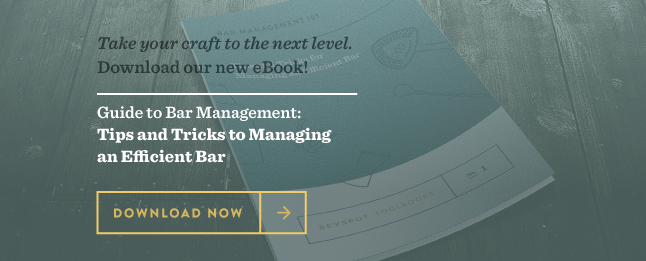
Schedule 15mins to chat with a product specialist
Start a FREE Trial Today! BevSpot offers full product education and account setup for all customers! No card Information needed!
Perk Up Your Bar with These 10 Coffee Beers
78% of the American adult population drinks coffee and 65% drinks alcohol. Of those who drink alcohol, 41% drink beer more than wine and liquor. It’s no wonder that two of America’s favorites have come together to form a powerhouse craft beverage.
Although it seems to have gained popularity in more recent years, coffee beer isn’t a new phenomenon. In 1984, Charlie Papzians’s The New Complete Joy of the Home Brewing notes the first written record of experimentation with coffee beer. Ten years later, New Glarus Brewing Co. was inspired by this homebrew recipe, which combined the flavors of coffee and beer. They became one of the first breweries to release a commercial coffee beer, their famed Coffee Stout. Although it faced a short legal battle due to the argument that caffeine and alcohol should not be mixed, coffee beer was deemed safe and is here to stay.
There are now an overwhelming amount of coffee flavored beer options. In fact, the Untappd app database lists over 10,000 beers made with some coffee component like coffee grinds, espresso, or cold brew.
Porters and stouts are usually a natural fit for the rich coffee flavor, but breweries are also experimenting with brown ales, cream ales, Belgian brews, IPAs, and a variety of other styles.
If you’re looking to stock your bar with coffee beer, we’ve listed 10 of our favorites to get you started. Keep in mind, many of these are seasonal.
1. Founders Breakfast Stout
Rated 99% ‘world-class’ on Beeradvocate and 100% on RateBeer.com, this Imperial Stout is truly top-notch. Founders describes it as “the coffee lover’s consummate beer.” At 8.3% ABV, it’s brewed with flaked oats, imported bitter chocolates, and two different types of coffee. Composition-wise, it has a powerful roasted coffee nose topped with a frothy, copper-colored head. This beer is easy to drink and a popular coffee stout that many of your patrons may be looking for! Available only during September-December, it can be purchased on tap or in 4 packs of 12 oz bottles. Serve this crowd favorite in a snifter glass.
2. Lagunitas Cappuccino Stout
This American Double/Imperial Stout is a heady 9.62% ABV, and it’s sold in 22 oz bottles or on tap. Brewed with “boatloads of roasted coffee,” it’s available mid-winter (January-February). The Beeradvocate crowd rated it 88% ‘very good’ and RateBeer.com gave it a 95% score overall. When poured, it smells like pleasing coffee and has a tan head with a dark coffee body. Serve it in a snifter if on tap and serve with a snifter on the side if you carry it by the bottle.
3. Ballast Point Victory at Sea
This coffee vanilla Imperial Porter is a “bold, smooth brew with just the right amount of sweetness.” Infused with Caffee Calabria coffee from San Diego, the big porter has subtle roasted notes of cold brewed coffee without the acidity, which balances well with its sweet caramel undertones of malt. The Victory at Sea is a whopping 10% ABV. There is a limited availability of 12 oz bottles, 22 oz bottles, and kegs. Beeradvocate rated this beer 97% ‘world-class’ and RateBeer.com gave it a perfect 100% overall. When you serve this beer, be sure to have a shaker or snifter glass on hand.
4. Sixpoint C.R.E.A.M.
The C.R.E.A.M. is a “bright blonde coffee ale” (essentially coffee in your cream ale). This beer certainly is unique. It gets its name from the famous Wu-Tang lyrics. It’s brewed with a blend of two-row, crystal malts, and pilsner! When poured, it has a very fresh one inch off-white head and a copper colored body. It has a crisp and refreshing taste and it has a lighter body than one would expect for a cream ale clocking in at 7.2% ABV. Rated 88% ‘very good’ on Beeradvocate and 67% overall on RateBeer.com, it’s very popular. You can purchase this beer in 6-packs with 12 oz cans and by the keg. Be sure to use a pilsner glass or a shaker pint when serving.
5. Oskar Blues Hotbox Coffee Porter
Based on the malt flavors of creme brulee, caramel, roasted nuts, and cocoa and infused with cold extracted coffee from Ethiopian and Burundi beans, this coffee porter is stellar. Because of the particular coffee that was chosen for this brew, there are hints of dark plums and blueberry, which pleasantly compliments the deep roast, chocolate and slight bitterness. This beer is a bit lighter compared to those previously listed with only 6.4% ABV. Wondering what the popular review sites have to say? Beeradvocate gave it an 88% ‘very good’ and RateBeer.com gave it a 96% overall. This beer is commonly sold in 12 oz 4 pack cans, but kegs can be purchased with rotating availability. If a customer orders this brew, serve it in a shaker or a nonick pint.
6. Sunday Morning Stout
What better way to start a Sunday morning (or end a Saturday night) than with a nice American Double/Imperial Stout? Especially one that’s 11.3% ABV! Aged in bourbon barrels, coffee and bourbon flavors jolt your senses followed by hints of caramel, roasted malt, vanilla, and chocolate. This beer is voted 96% ‘world-class’ on Beeadvocate and 99% overall on RateBeer.com. The Sunday Morning Stout is a Spring seasonal and can be purchased either on tap or in 12 oz bottles. Because it’s a stout, you should serve it in a snifter glass.
8. Cigar City Cubano Espresso
People go crazy for Cuban coffee, so this Cuban-style Brown Ale is sure to be a big hit. Brewed with a heaping amount of espresso beans, cacao nibs, and vanilla, this 5.5% ABV beer gets it done without being overpowering. When poured, it has sweet caramel, toffee, and nutty aromas, and it looks dark brown with a large tan head. This English Brown Ale is scored 91% ‘outstanding’ on Beeradvocate and 98% overall on RateBeer.com. You can purchase it year-round in both cans and on tap. To best serve your guests, use a seidel mug or a shaker.
9. Green Flash Cosmic Ristretto
Talk about out of this world! This revved up, rich black brew will definitely make your customer’s day. Made with smooth espresso and hints of sweet chocolate malts, this 8.2% ABV Baltic Porter has an easy drinking texture and a mellow sweetness. As of last month, it’s now available year-round and can be purchased on draft or in 22 oz bottles. This beer has an 87 ‘very good’ rating on Beeradvocate and is not yet rated on RateBeer.com. Once this is stocked, serve it to your patrons in a shaker, nonic pint, or a seidel mug.
10. Coronado Imperial Blue Bridge Coffee Stout
Both the coffee addict and novice coffee drinker will love this coffee stout. Made with two-row malt, roasted barley, and Guatemalan coffee from their local coffee shop, Cafe Moto, this 8% ABV stout has earthy and sweet chocolate flavors. This beer was released in January as Coronado’s new winter seasonal, so it doesn’t have enough reviews on Beeradvocate or RateBeer.com to have a final score. The Blue Bridge is currently only available in Arizona, California, Hawaii, Illinois, Massachusetts, Michigan, Nevada, New Jersey, North Carolina, Pennsylvania, and Wisconsin. If you’re in their regional distribution area and choose to stock your bar with this brew, be sure to serve it in a snifter glass!
Now that you have a solid list of 10 coffee beers to choose from, you should easily be able to stock your bar with stellar coffee beer options. For more information on the correct glassware to use, be sure to check out our Beer Glassware Guide.
Top Selling Spirit Brands in Q4 2015
Have you ever wondered which spirits drive the most sales?
We have, too. So, we took a look at all of the orders that went through our system in Q4 of 2015. We gathered BevSpot data from a representative cross section of accounts to uncover the 51 spirit brands that performed best.
The results are pretty interesting: take a look at the graphs to see where your company’s product—or your favorite brand—performed.
Top Selling Spirits Brands – The Results
10 New Twists on the Classic Old-Fashioned
Here are 10 versions of the classic Old-Fashioned cocktail for you to mix up.
There are certain cocktails that are timeless. When someone orders one, you can picture each ingredient and the exact preparation. You know the glass, the garnish, and whether to shake or stir.
One of these classic cocktails is the Old-Fashioned.
This iconic drink seriously is old fashioned. In fact, it has been around since the early 1800s when the private social club, Pendennis, was credited for making the very first one.
When someone orders an Old-Fashioned, reach for rye whiskey and pour two ounces into a mixing glass. For a sweetener, crush a sugar cube. Then comes two dashes of Angostura Bitters. Finish off the drink with a splash of water and a good stir. Before handing it to your guest, pour the final concoction over a few large ice cubes in a chilled Old Fashioned glass and garnish with an orange peel twist.
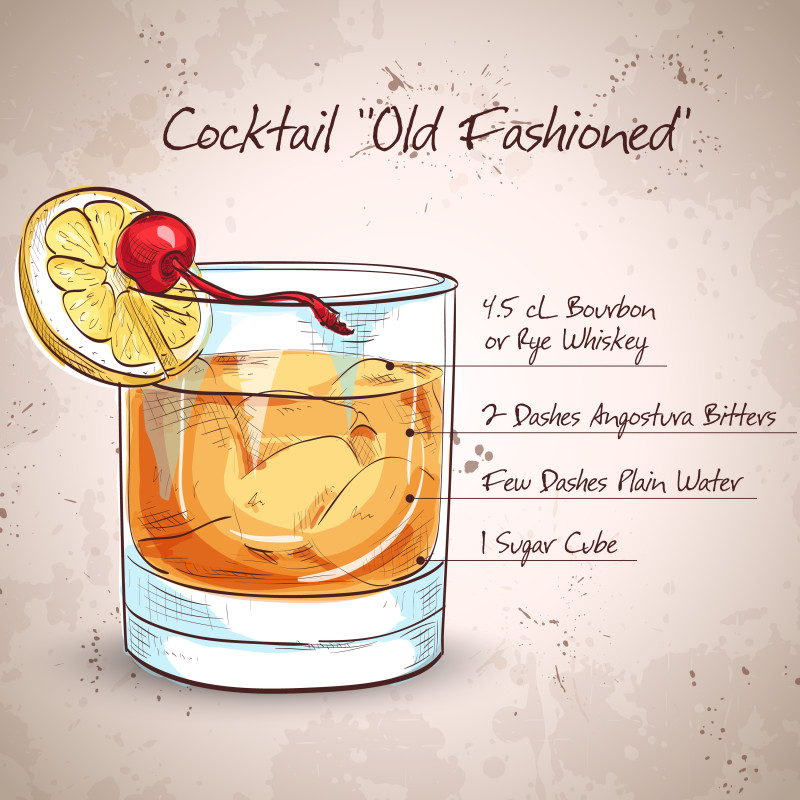
Since its birth hundreds of years ago, the Old-Fashioned’s components have taken some twists and turns. Some bartenders prefer to use brown sugar, some like to use bourbon instead of rye whiskey, and some garnish with a lemon peel.
The Old-Fashioned’s recipe also can vary by geography. In Kentucky, bartenders commonly use bourbon, a muddled cherry and orange, and a splash of soda water. In Wisconsin, Old-Fashioneds are often made with brandy.
Although it’s a classic, there’s no reason why we shouldn’t conduct a little cocktail experimentation. With a good idea of the basics, additions and substitutions can make for an exciting new spin on an old favorite for both the mixologist and patron.
Sour-Cherry Old-Fashioned
Sour cherries might be too tart to eat by themselves, but if you muddle them, and combine them with sugar and whiskey, they’re pretty darn delicious. Mix up this new spin on the classic Old-Fashioned created by Mark Bittman, a columnist for the New York Times Magazine.
Ingredients
2 Sour Cherries, stemmed and pitted
1 Orange Peel Strip
1 Sugar Cube
2 or 3 Dashes of Bitters
2 oz Rye or Bourbon
Preparation
1. Put the cherries, orange peel, and bitters into an Old-Fashioned glass
2. Crush the cherries and sugar with a muddler
3. Fill the glass with ice
4. Add whiskey
5. Stir until drink is cold
House Old-Fashioned
Usually Old-Fashioneds are made with whiskey, but Ryan Lotz of No. 9 Park in Boston likes to mix it up with a cognac variety of brandy for a smooth finish. Ryan mastered the art of bartending after graduating from Boston University. He was on the opening team for Jackson Cannon’s, The Hawthorne, before settling in at No. 9 Park.
Ingredients
3 Dashes Angostura Bitters
3 Dashes Orange Bitters
¼ oz Demerara Syrup
1 ½ oz Paul Beau V.S. Cognac
1 ½ oz Privateer Amber Rum
Preparation
1. Combine all ingredients
2. Stir over a block of ice
3. Garnish with orange and lemon twists
Aquavit Old-Fashioned
Dustin Knox, the owner of Central in Portland (OR), holds an Old-Fashioned happy hour where he offers 10 different versions of the cocktail. One of his variations is called the Aquavit Old-Fashioned. He finds that Aquavit’s flavor matches well with honey, Angostura, and orange bitters.
Ingredients:
1 tsp Honey Syrup (½ cup honey combined with ¼ cup hot water)
2 Dashes Angostura Bitters
1 Dash Grapefruit Bitters
1 Dash Orange Bitters
2 oz Aquavit
Orange and Grapefruit Peels
Preparation:
1. Add honey syrup, bitters, and Aquavit to an Old-Fashioned glass
2. Stir
3. Add a large piece of ice or several large cubes and stir to chill
4. Cut thin swaths of zests from grapefruit and orange for garnish
Salt Fashioned
If you’re looking for something a bit on the saltier side, check out the Experimental Cocktail Club’s Salt Fashioned! For an Autumn-like approach, they add maple syrup and apple bitters to the mix – yum!
Ingredients:
5 Dashes Bar Keep Apple Bitters
1 tsp of Salted Maple Syrup
2 oz Laphroaig Whiskey
1 Lemon Peel
Preparation:
1. Fill a mixing glass with ice
2. Add apple bitters, salted maple syrup, and whiskey
3. Stir until well chilled
4. Strain into cold rocks glass over ice
5. Garnish with a lemon twist
Baked Apple Old-Fashioned
The Breslin in New York City has their own version of an Old-Fashioned. They’ve decided to give it an apple twist and they call it the Baked Apple Old-Fashioned.
Ingredients:
1 oz Laird’s Applejack
1 oz Overholt Rye
.75 oz Spiced Apple Syrup (combine apple cider, nutmeg, cinnamon, and star anise with a dash of demerara sugar)
2 Dashes Angostura Bitters
Preparation:
1. Add all ingredients into mixing glass with ice
2. Stir
3. Strain over ice into Old-Fashioned glass
4. Garnish with grated nutmeg
Desert Rose
The husband and wife co-owners (Brooke Williamson & Nick Roberts) at Playa Provisions, encourage people to experiment and have fun with Old-Fashioneds. They recommend starting with a base spirit and inspire people to change ratios, substitute spirits, and trade out syrups and bitters. One of the new Old-Fashioneds featured at their restaurant is the Desert Rose, made with tequila!
Ingredients:
1 ½ oz Reposado Tequila
½ oz Mezcal
¼ oz Agave Syrup
1 Dash Angostura Bitters
Ancho Chili Powder
Rosemary Stalk
Preparation:
1. Light rosemary on fire and cover with a glass, allowing smoke to fill it
2. Roll edge of glass in ancho chili powder
3. Add all ingredients to glass
4. Add ice cube
5. Stir
Bacon Old-Fashioned
The average American eats nearly 18 pounds of bacon a year, so why not add it to a cocktail as well? The Patterson House in Nashville creates a new take on an old cocktail by adding this American favorite.
Ingredients:
.25 oz Maple Syrup
2 oz Bacon-Infused 4 Roses Bourbon
7 Dashes Coffee Pecan Bitters
Preparation:
1. Combine all ingredients in a mixing glass with ice
2. Mix
3. Strain into Old-Fashioned glass over one large ice cube
Meemaw’s Fig Jam Old-Fashioned
From the River Bar at Sea Island Resort in Georgia, this Old-Fashioned is a little on the sweeter side – with a heaping spoon of Fig Jam!
Ingredients:
1 Generous Bar Spoon of Fig Jam
1 Thinly Sliced Orange Wheel
2.5 oz Basil Hayden Bourbon
2 Dashes Angostura Bitters
Preparation:
1. In a mixing glass, muddle fig jam and orange
2. Add bitters, bourbon, and ice
3. Stir
4. Strain into an Old-Fashioned glass
5. Top with fresh ice and add the peel
Young Laddie
Joaquin Simo, 2012 Bartender of the Year, has a unique idea for an Old-Fashioned. He uses two forms of grapefruit and suggests that you avoid smoky Scotches and go big on the twists.
Ingredients:
2 oz Bruichladdich “Rocks” Scotch whiskey
¼ oz Simple Syrup
1 Dash Peychaud’s Bitters
1 Dash Bittermens Hopped Grapefruit Bitters
Orange Twist
Grapefruit Twist
Preparation:
1. Combine all ingredients (except twists) in an Old-Fashioned glass
2. Add one large chunk of ice and stir until chilled
3. Twist wide piece of orange zest and wide piece of grapefruit zest over drink and drop them in
Re-fashioned
This is a creation from BevSpot’s own, Tom McNeill. When questioned about whiskey and bourbon – Tom said “I don’t drink that stuff” and proceeded to rattle off the following recipe:
Ingredients:
2 oz Aged Rum
¼ oz Simple Syrup
1 Dash Angostura Bitters
Cherry
Orange twist
Preparation:
1. Muddle orange and cherry in Old-Fashioned glass
2. Add ice, rum, simple syrup, and bitters
3. Stir until chilled
As you can see, the Old-Fashioned has taken some interesting twists and turns since its original creation. It has a rich history with ingredient variations based on region, personal preference, and experimentation. What’s your favorite version of the Old-Fashioned? Do you have your own, unique recipe? Tell us by commenting below.
Want to know more about the Old-Fashioned’s glassware? Check out our Cocktail & Spirit Glassware Guide!
Schedule 15mins to chat with a product specialist
Start a FREE Trial Today! BevSpot offers full product education and account setup for all customers! No card Information needed!
Glassware Guide for Cocktail & Spirit Enthusiasts
Even if you perfectly pick, measure, and mix your cocktail ingredients, or perfectly pour a spirit if you’re not using the correct glassware, your customer is missing out on a quality drinking experience. When it comes to cocktails and spirits, there are a variety of glasses to choose from. Some pairings, like the iconic martini glass, might be more obvious but others might not be so evident. Here’s a full glassware guide for cocktails to lead you through your cocktail pairings and to bring your bar manager skills to the next level.
Start Your Free Trial With Bevspot Today!
The Cocktail Glass
Although people might argue about the extent a glass has on cocktail or spirit taste, there’s no denying that beautiful glassware tends to be perceived as being higher quality. Many glasses, like the martini glass, are classic and have been used with certain cocktails for decades. Others, like the more recent NEAT glass, are designed to accentuate the aromas of spirits.
Cocktail and spirit glasses come in many different shapes and sizes. For a basic diagram, you can look at a typical glass as having four parts: Brim, Body, Stem, & Foot.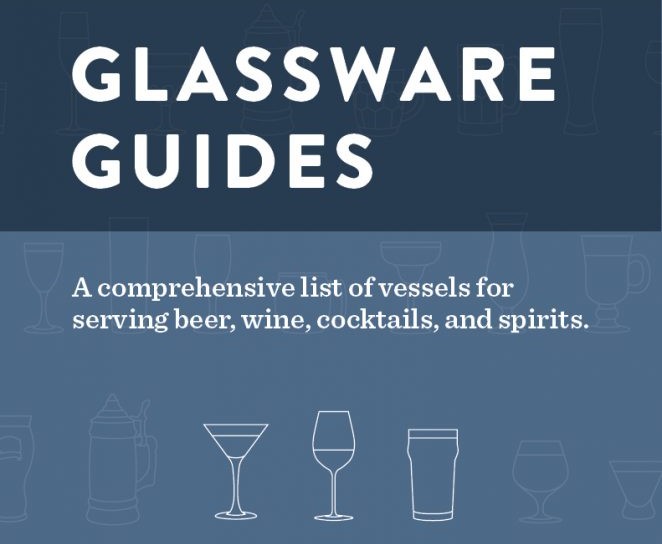
The Shelf
In order to promote a well-rounded drinking experience, you should try to stock your bar with a number of these glasses. Specific glassware will show your patrons that you’re serious about the art of alcohol. Also, because many customers probably don’t have individual glass pairings at home, they’ll remember that special experience they had drinking a nice Irish Coffee out of an authentic Irish Coffee glass at your bar.
Lowball
This class is also called the Old Fashioned glass, the Rocks glass, or the Tumbler. Unlike a mixing glass, this short glass is designed so you can build the cocktail inside the glass it’s being served in. The Lowball glass has a thick base to allow ingredients to be muddled in the glass before the spirit is added. Its rim wide brim lets the drinker appreciate the drink’s aroma and the shape allows the drink to warm slowly, discretely changing the flavor profile. Avoid using this glass for vodka drinks because vodka is best cold.
Typically, this glass is used for smaller, higher-proof pours like hard spirit-based cocktails that have a limited amount of mix or straight spirits with ice (on the rocks). Originally, this glass held two ounces but now there are usually two sizes for a broader cocktail application. Now a standard Low Ball glass holds about 6-10 ounces and a double holds 12-16.
SIP THIS
- Old Fashioned
- White Russian
- Mojito
- Negroni
- Whiskey on the Rocks
Highball
A Highball glass, also called the Collins glass or the Delmonico glass, is taller than an Old Fashioned glass. Each name is used to describe a variation of the basic shape: the Highball glass is shorter and wider, the Collins glass is straight and narrow, and the Delmonico is the shortest and somewhat flared. Traditionally, each glass variation is used for a different type of cocktail: the gin fizz going in a Highball, a Tom Collins in a Collins glass, and a Rickey going in a Delmonico glass. Although some mixologists abide by these rules, the important thing to note is tall and narrow shaped glasses are better for keeping a drink cold and carbonated because of the limited surface area.
The Highball glass is best used for serving highball cocktails, a family of mixed drinks that are made with an alcoholic base spirit and a larger portion of non-alcoholic mixer such as a Rum & Coke or a Gin & Tonic.
SIP THIS
- Rum & Coke
- Gin & Tonic
- Dark & Stormy
- Screwdriver
- Bloody Mary
Shot
This type of glass is for customers who want to take a shot (have a drink in one sip). Usually this drink is simply a single liquor or spirit or for a small extra strength cocktail. Shot glasses come in a variety of shapes and sizes like basic, short, tall, and fluted. You can stock your bar with any variation of these.
SIP THIS
- Tequila
- Whiskey
- Fireball
If you’re serving shooters (strong, small, mixed cocktail), you can use a shooter glass, which is similar to a shot glass but usually about ½ an ounce or more than 1 ounce bigger.
SIP THIS
- Snakebite
- Irish Car Bomb
- Water Moccasin
- Alice in Wonderland
- Girlscout Cookie
Martini
The Martini glass, also called the Cocktail glass, is an elegant, iconic V-shaped glass with a stem. The V-shape creates a wide brim, allowing for the release of aromas and it helps to hold the structure of the drink so the contents don’t separate over time. Because this glass is for drinks that are shaken or stirred without ice, the glass has a thin stem so the drink isn’t warmed through body heat.
SIP THIS
- Vodka Martini
- Gin Martini
- Vesper
- Brandy Alexander
Cosmopolitan
A Cosmo glass has an elegant look. It resembles a martini glass but instead of a stem, it has a foot. This glass is great for Cosmopolitans (obviously) and a variety of other cocktails. The tapered design showcases the colors of the cocktail and draws the flavors and aromas to the top.
SIP THIS
- Cosmopolitan
- Aperitifs
- Other Cocktails
Snifter
This glass is usually used for aged brown spirits such as whiskey, brandy, and fine rums. It has a very short stem so the drinker’s hand will slowly warm the drink and a large bowl so the drink can be swirled. The mouth is shorter so the aromas are trapped, allowing the drinker to enjoy a more intense smell as they sip.
SIP THIS
- Whiskey
- Brandy
Irish Coffee
When serving hot cocktails like an Irish Coffee or a Hot Toddy, you should use an Irish Coffee glass. This glass is made to be heat resistant and it features a handle so the drinker can hold and sip the drink comfortably.
SIP THIS
- Irish Coffee
- Hot Toddy
Hurricane
This glass was developed by New Orleans tavern owner Pat O’Brien in the 1940s and named after its hurricane, lamp-like shape. It’s used for a variety of drinks, specifically for tropical cocktails. The glass has a curvy and tall shape made up of a tulip-shaped bowl and a bulbous base. It also features a short stem and a small foot. This glass was originally used for the Hurricane Cocktail, a rum-based cocktail, but it is also used for cocktails like the Blue Hawaii and the Pina Colada.
SIP THIS
- Hurricane
- Blue Hawaii
- Pina Colada
- Lava Flow
Margarita
This glass is a variant of the classic champagne coupe and it’s slightly larger and rounder than a cocktail glass. It has a large, broad-rim so it can hold salt or sugar. This glass is used for frozen drinks like a margarita or a margarita on the rocks.
SIP THIS
- Margarita on the Rocks
- Frozen Lime Margarita
- Frozen Strawberry Daiquiri
Moscow Mule Mug
The Moscow Mule has been served in a copper mug since it first appeared in the the 1940s. The metal quickly takes on the cold temperature of the drink, offering a cooler sensation to the drinker. The copper and the mug handle help to keep the drink cold for a long period of time and the material is also great at deflecting the heat from the sun.
As far as the taste, the copper mug helps to enhance the individual flavors of the vodka, ginger beer, and lime. When the drink is poured, the copper begins to oxidize and slightly boosts the aroma and taste of vodka, the lime juice’s acidity is reduced and its tangy citrus notes are heightened, and the ginger beer becomes more bubbly.
- Moscow Mule
- Kentucky Mule
Whiskey Sour
This glass is pretty much a shorter version of a wine glass. It’s used for drinks with a base spirit, a sweetener, lemon or lime juice, and traditionally egg white like a Whiskey Sour or an Amaretto Sour. The glass has a thick stem to provide stability and a narrow top to boost and intensify drink aromas.
SIP THIS
- Whiskey Sour
- Amaretto Sour
- Pisco Sour
- Kamikaze
- Sidecar
Zombie
As you may have guessed, the Zombie glass was originally used to serve a drink called the Zombie, a cocktail invented in the 1930s at the Beachcomber restaurant in Hollywood. The glass is typically taller than other glasses, coming in at around 7 or 8 inches tall and holding between 13 to 14 ounces of liquid.
SIP THIS
- Zombie
- Mojito
- Tom Collins
Cordial
Considered to be an elegant glass, the cordial resembles a wine glass but it’s more delicate, thinner, and holds less alcohol. usually the cordial is used for after-dinner liqueurs or for cocktails at events. Cordials are small because they are meant to be sipped from slowly. They have large bowls that allow you to swish the liquid around to release the flavor and aroma.
SIP THIS
- Cordial
- After-Dinner Liqeuer
- After-Dinner Drink
NEAT
Relying on a number of scientific facts about the behavior of liquid vapor in an open container, the NEAT glass is making waves in the spirits community. Its tulip-shaped body helps to concentrate the evaporated compounds at the neck. With a broad bulbous shape, it creates a larger surface area allowing for more evaporation. This expedites the release of alcohol vapor and volatile compounds. The flared lip helps to expel lighter vapor and leaves heavier compounds down by the neck, supposedly helping to accentuate aroma compounds with less alcohol burn.
SIP THIS
- Whiskey Neat
- Bourbon Neat
- Rye Neat
- Scotch Neat
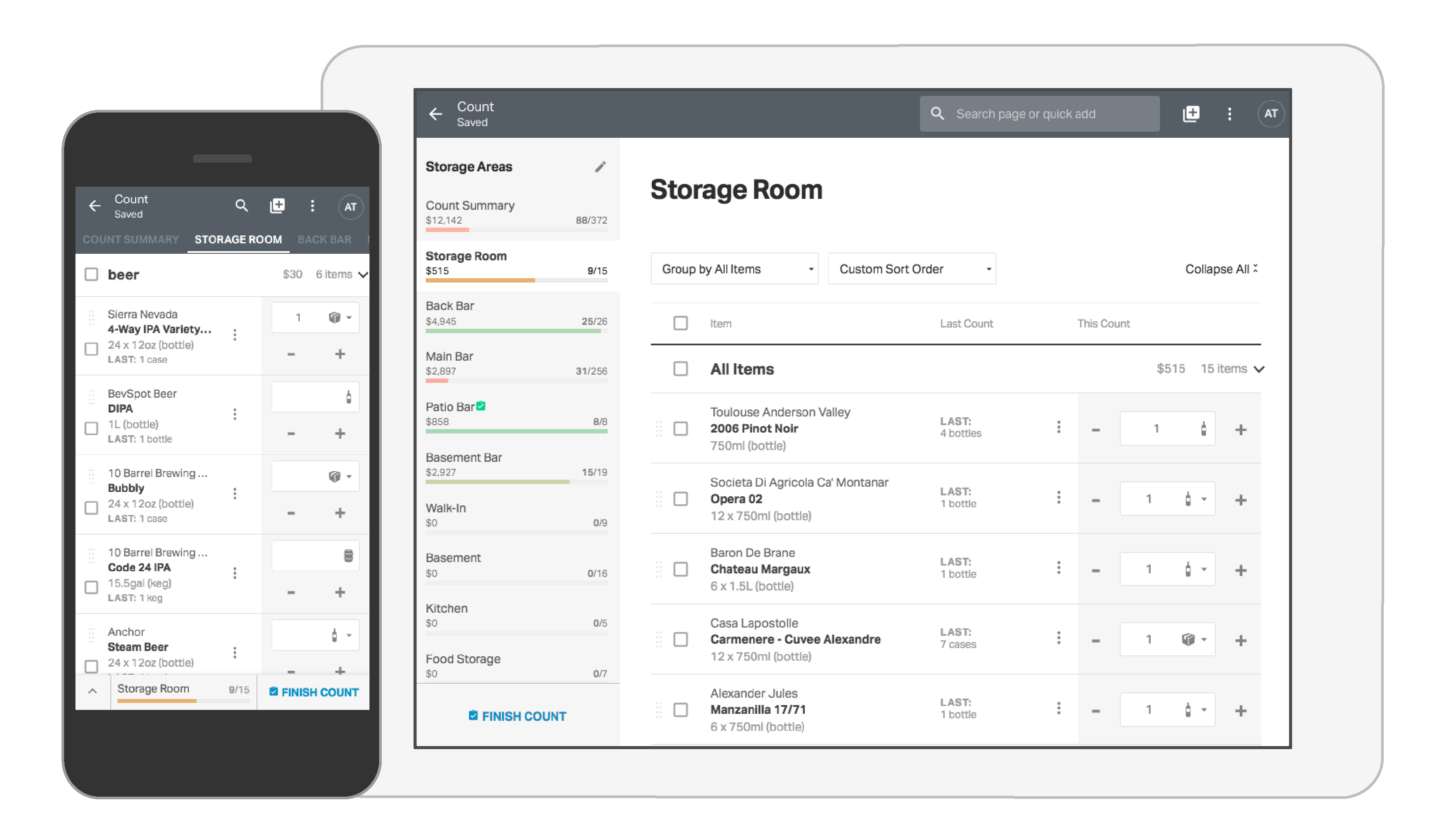
Schedule 15mins to chat with a product specialist
Start a FREE Trial Today! BevSpot offers full product education and account setup for all customers! No card Information needed!
7 Reasons Why You Need to Take Bar Inventory
Have you ever taken bar inventory?
You probably don’t even like the fact that I just brought it up. (Sorry)
I know you probably don’t want to be reminded of the seemingly endless hours you’ve spent from 3 am until the break of dawn counting every single bottle behind the bar. You also probably don’t want to picture the multi-tabbed Excel spreadsheets and the number crunching.
If you haven’t done bar inventory, now that I’ve described it, you might consider skipping it.
Don’t skip it. Bar inventory is necessary for running a successful bar. Here’s why:
1. No More 86’ing Products
No one likes to hear, “I’m sorry, we’re out of that!” Especially if he orders something else and you’re out of that product too. If you don’t keep track of how much product you have behind the bar, you’ll run out of product without knowing it, and you’ll likely have some frustrated customers on your hands.
Taking bar inventory will help you avoid this sticky situation. If you stay on top of it, you’ll be aware of diminishing product early-on, giving you time to order more before you 86!
2. Understand inventory dollar usage information
Your inventory is your largest asset. It represents an investment of your business’s cash and it can’t be used for other outflow purposes. If you’re just buying things without keeping track, you’re not going to have a very good understanding of where your inventory dollars are going.
Remember, every dollar you spend on inventory is a dollar you can’t put towards other costs. You need to keep track of how much and what variety of product you have so you don’t overstock or understock your shelves – and you purchase product that sells.
3. Ensure your inventory is really making it out to your paying guests
Say your distributor offers you a big sale on Shock Top. You decide to buy a few cases because he made the deal sound really worthwhile. However, what if you don’t even have Shock Top on the menu and it’s just sitting in the back room? Or, what if Shock Top just isn’t a big seller with your customer base? Without taking inventory, you won’t know if the product you purchased is actually selling. Taking frequent inventory will help you ensure your products are actually making it out of the back room and into your guests’ hands.
Remember, your investment in your inventory has a significant impact on your cash flow. If you over-invest in inventory, you’ll reduce the amount of cash you can use for other outflow purposes like rent and payroll. Every bottle sitting on your shelfs and in your back room represents unusable cash.
Taking inventory will help you gain a better understanding of how quickly your products are resold, helping you to set accurate pars so you don’t overstock your shelves and tie up your costs.
4. Identify theft
If you don’t take inventory, product could be disappearing without your knowledge. In fact, it’s estimated that internal theft costs bars 24 to 26% of gross sales on average. Although you’d love to trust your staff, it’s important to keep track of your sales.
Keep in mind, loss doesn’t always mean your employees are actually walking out the back door with liquor bottles. It could also mean they’re over-pouring or replacing well brands with call brands.
If your bar staff knows you don’t take inventory, they might be even more inclined to give away free drinks and/or take bottles for themselves because they know it will take you a while to catch on.
Taking inventory will help you notice when your sales and inventory don’t match up. If you’re thorough, you’ll be able to pinpoint what product is missing, how much is missing, and even when it went missing.
5. Weed out poorly-priced menu items
You could have a drink on your cocktail list that nobody ever orders or a beer variety that’s collecting dust. Maybe they’re priced too high for your bar demographic, or maybe they’re just not crowd favorites. On the other hand, you could have a popular wine variety that’s flying off the shelves that you could afford to bump up a dollar.
If you don’t keep track of what leaves the bar, you won’t know what’s selling and what isn’t. Taking inventory can help highlight products that need your attention. This way, you can address the problem with a price switch or by replacing the product entirely.
6. Assess pouring accuracy
Sure, every now and then your bar staff will spill a drink or accidentally overpour. However, what if they’re constantly making mistakes? If your bartenders are free pouring without jiggers, there’s a chance their count is off and they’re constantly overestimating their ounces. To prevent this, you should properly train and continuously retest your staff in the art of free pouring. You should also take inventory to see if recorded sales and the amount of remaining product match up. If there’s a significant variance, it could be due to inaccurate pouring.
7. Make sure you’re not overstocking perishable items
If you don’t know how many limes you have, you might decide to order a few more cases only to later find some cases in the storage room. Because you didn’t keep track, you now have too many limes and there’s no way you’ll be able to use them all before they start growing fur. Keeping an updated inventory count will provide you with valuable information to help you avoid wasting product and throwing your money away.
As you can see, taking inventory is necessary for running a successful bar. Although bar inventory isn’t the most glamorous of tasks, BevSpot’s bar management software can cut down the time it takes, set up pars to ensure inventory levels, track product usage, and combine orders and inventory numbers to help you better understand your bar.
Sound like something you’d be interested in? Schedule a demo with one of our product specialists to find out how we can help.
Start a FREE Trial Today! BevSpot offers full product education and account setup for all customers! No card Information needed!
Bar Management: Ordering and Invoicing 101
What’s the most important part of bar management for you? Finding the best cocktail recipes? Promoting your bar on Facebook?
What about controlling your bar’s liquor inventory?
It’s the least sexy part of being a bartender, we know. But without efficient inventory management and solid processes behind the scenes, it’s difficult to run a successful bar.
Understanding exactly how to do liquor inventory is the first step.
Next, you’ll need to keep an organized record of your orders and invoices—of everything you bought and sold, and when.
However, ordering and invoicing for a business is complicated. Especially for a bar.
It involves endless paper trails, a high volume and variety of product flow, and the need to coordinate with many different people. Some bar managers use traditional pen-and-paper methods, and others make it easier with inventory management software.
We’re here to shed some light on the complexities of bar management, which include learning how to manage invoicing and ordering for your bar.
Let’s get down to business.

Find out how to take inventory 3x faster.
Ordering Inventory for a Bar
After counting your liquor inventory and determining your usage, it’s time to put together that order.
- Take the invoices from last week’s order and enter them into the excel sheet that contains your usage totals. You’ll compare this usage to last week’s invoices, and determine how much product you went through versus what you took in.
- Once you have compared the numbers, go through and create your new order totals, looking at what you have in-house versus what you should have for the next week. You should be able to check your pars to easily determine what next week’s order totals should be (find out how to set pars for your bar here).
- Sort through each liquor category and create order totals for each type.
- Stop. Review the totals, and ask yourself if you really need all that liquor. Always consider ways to reduce your sitting inventory.
- Once you’re satisfied with the order, segment the totals into distributor categories.
- Now it’s time to call in each order to your reps. Allow enough time to get those orders in before the deadline, and avoid surrendering to any upsells they offer; you probably don’t need this extra product—it’s usually unnecessary spend and it’ll take up valuable space on your shelves.
- When the liquor orders are delivered, check the invoice sheet against the delivered product and make sure the numbers match. Identify any discrepancies, and save these invoices for next week, filing appropriately.
How to Manage Your Bar’s Invoices
An important part of taking liquor inventory is knowing how much product you’ve used (or lost) during a given period. But without keeping track of your invoices and comparing them to your usage and sales data—which we’ll look at in part 3 of this blog series—you won’t know what was sold and when.
Without a visible invoice history, it will be impossible to track whether or not product has been sold, gone missing, or been given away for free. You won’t be able to monitor pour costs or easily calculate drink prices.
Bar managers need to adequately control their invoicing process for the following reasons:
- Determining usage in dollars
- Setting appropriate pars for all liquor
- Tracking spending
- Comparing this spend to sales income
- Managing pour costs
- Lowering sitting inventory
There’s no easy way to track a paper trail of invoices. Unless you invest in ordering and invoicing software that’ll do it for you, it’s simply going to take time and organizational skills. We generally recommend filing invoices in date order, and then alphabetically by distributor. But if you can further categorize them by liquor type, you’ll save some extra time. This way, when you’re comparing invoices with the PMIX report from your POS, you’ll have the most recent invoices clearly categorized and readily available.
Without an organized and efficient invoicing system, it’s impossible to keep track of your sales history, of what you used and how much, of what worked and what didn’t. This information is crucial to better managing your sitting inventory, pars, orders, and profitability in the future.
In part 3 of this series, we’ll go through the step-by-step process of exactly how to do this.
Ordering and invoicing for a business can be a painful process. So we decided to make it easier.
With BevSpot’s inventory software, your usage counts, orders, and invoices are kept in one easy-to-use platform. Orders are automatically generated and sent to all your reps with one click. Invoice history, POS data, and all those important sales numbers are displayed in one clean package.
Schedule 15mins to chat with a product specialist
Start a FREE Trial Today! BevSpot offers full product education and account setup for all customers! No card Information needed!
How to Serve a Proper Beer
You want to give your customers great tasting, refreshing beer. You want it to look good, taste good, and be an overall quality drinking experience. You don’t want a customer to send a beer back, or worse, struggle through it because they don’t have the guts to tell you it’s not right. When it comes to beer, there are a number of points where quality can be compromised. It’s your job to make sure it makes it to the customer in pristine condition.
In order to protect a beer’s quality, it’s important to know where trouble can arise. To keep beer in tip top shape, pay careful attention to these four points in its journey: 1) draft lines, 2) temperature, 3) glassware, and 4) pouring.
1. Draft Lines
You want to serve a perfect beer – not one that’s cloudy, moldy, or tastes funny. And you definitely don’t want to make a customer sick. Over time, beer lines can get clogged with yeast, bacteria, mold, and beer stones. Watch out, all of these components will negatively affect the taste.
Yeast found in draft lines may be leftover from the brewing process, or it could be wild yeast found in the environment. It’s usually white or grey and found on the surfaces of the beer system that are exposed to air like faucets, drains, and keg couplers.
Bacteria, although not significantly risky to human health, can affect the appearance, aroma, and taste. If bacteria is present, the beer will have an unappealing cloudy look and an “off taste.” Beer spoiled by bacteria is supposed to taste sour or like vinegar, and it may smell like rotten eggs.
Mold can get into the beer system if it’s exposed to air. Usually found as surface growth in areas exposed to air, mold grows on beer system pieces like keg couplers, drains, and faucets. It’s usually black or brown.
Beer stone is a mysterious calcium buildup made of raw materials, water, and grain. As it develops, it eventually flakes off inside the beer tubing if the system is not properly maintained. A large amount of beer stone can negatively affect taste. Beer stone is usually grey or brown.
The majority of establishments hire an outside company like Lenox Martell to flush out the lines with specialized equipment and cleaning solution. It’s recommended that you get your draft lines cleaned after every keg or a least every two weeks. There are also specific state guidelines and brewery recommendations you should follow. You should also get your draft lines replaced anywhere from every year to every five years.
2. Temperature
Experts believe that most beers have an ideal serving temperature. Usually, the optimal serving temperature relates to its strength. As beers become more alcoholic, they are usually served warmer because they are generally sipped more slowly and appreciated for their intricate flavors. Beers with a lower alcohol content are usually more for refreshment so they are kept at colder temperatures.
Although some craft beer bars have the ability to hold their kegs at different temperatures, the majority of bars control keg temperature with one central system. It is suggested that bars store kegs below 40°F (ideally at 38°F). If beer is stored above 40°F, its spoiling factors increase which can result in oxidative flavors. The beer will also foam, releasing carbon dioxide bubbles that can affect the taste and appearance of beer and take up 25% of your beer keg, essentially wasting ¼ of your supply.
Not only should you concentrate on the keg temperature, but you should also pay attention to the serving temperature. To ensure beer remains the same temperature from keg to glass, make sure your beer lines are insulated. Also, depending on the brew, decide whether to pour it into a room temperature or chilled glass. But never use a frosted glass, because it makes it difficult to smell and taste it, and it also creates unwanted foaming.
3. Glassware
Grabbing a glass to pour a draft beer into shouldn’t be a mindless activity. In addition to the glass’s temperature, you should also be thinking about the glass’s shape and cleanliness. These steps are vital for serving a quality beer from keg to glass.
Glassware can make a big difference. When it comes to a quality drinking experience, presentation is key because it’s the first thing the customer sees. If beer looks pleasing to the eye, customers are already on their way to a positive experience. The shape of the beer glass can also affect the formation and retention of head. A healthy head of foam helps to retain volatiles including compounds of hop oils, spices, and fermentation byproducts. These are important for a beer’s aroma, which makes up a huge percentage of what people taste.
If beer glasses aren’t rinsed or washed properly, residue will form on the inside. When this happens, bubbles stick to the sides of the glass and head creation and flavors may be inhibited. The savvy beer drinker knows this is the sign of a glass dirty with grease, food particles, soap, or sanitizer. Even if they don’t recognize the mistake, dirty glasses are unacceptable. The only thing that should be in a customer’s glass is quality beer.
When you serve bottled or canned beers, you should also provide your customers with the proper glass. Unless customers are planning on chugging it, they’ll appreciate your dedication to craft beer and the drinking experience.
4. Pouring
Pouring the perfect pint is the last step in a beer’s journey. Much like choosing the right glass, correctly pouring a beer is essential for providing the customer with a quality product. To pour a beer, hold the glass at a 45° angle and pour the beer and aim towards the middle of the slope of the glass. When the glass is about ⅔ of the way full, hold the glass at a 90° angle (upright) and keep pouring towards the middle of the glass in order to create the perfect foam head of about 1 to 1 ½ inches. At this point, it might also help to slowly add some distance from the the glass as you pour to create more of a foamy head.
If you pay careful attention to each step in a beer’s journey, you’ll ensure your customer gets a great beer every time. For more information on serving a quality beer, check out our interactive Beer Glassware Guide below.
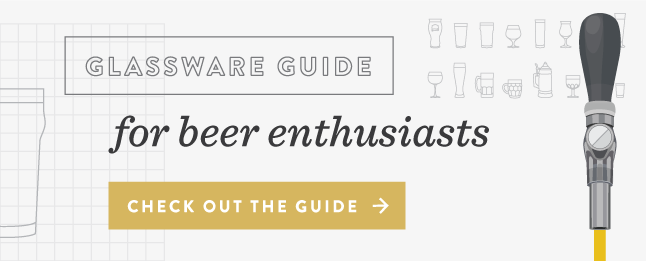
Glassware Guide for Beer Enthusiasts
Even if you choose a quality beer and pour the perfect foam head, if you don’t consider your glassware, you’re limiting the beer-drinking experience. Many beer experts believe that unique glassware can have a variety of effects on the the beer drinking experience.
According to the popular website, Beeradvocate:
“As soon as the beer hits the glass, its color, aroma and taste is altered, your eye candy receptors tune in, and your anticipation is tweaked. Hidden nuances become more pronounced, colors shimmer, and the enjoyment of the beer simply becomes a better, more complete experience.”
Experts like Ray Daniels, the creator and director of the Cicerone Certification Program and president of the Craft Beer Institute, agree that glass- ware is essential for an elevated beer-drinking experience.
If a customer asks for an imperial stout, do you know what glass to pour it in? What if he orders a saison or a hop-forward beer?
Start Your Free Trial With Bevspot Today!
The Beer Glass
Wondering what terms to use to describe the different parts of a basic beer glass how these parts relate to the beer it contains?
When you serve a beer, the head sits at the top near the lip or mouth of the glass and the body of the beer takes up the body or bowl of the glass. The base of the glass keeps the beer steady and upright when it’s placed down on the bar or table. Although the shape and size of beer glassware can widely vary, every beer glass can be identified by these three basic parts.
The Round-Up
Are you ready to dive into the specifics of beer glassware? Don’t worry, your bar doesn’t necessarily need to be stocked with every single one of these. However, if you identify as a craft beer bar, you might want to consider it. This is a great way to start thinking about how you can create an elevated drinking experience that customers will want to come back for.
Stop serving every beer in the same glass! Take a look at the list below to diversify your beer glass collection.
Shaker Pint

The pint glass, or the standard pub shaker, gets a bad rap among most beer enthusiasts. These glasses weren’t intend- ed for beer. They were originally used behind the bar to shake cocktails. In the post-prohibition era when American beers were less alcoholic and bland, people started using the pint glass for beer. This practice stuck.
If you’re serving a finely crafted beer in a pint glass, your cus- tomer’s grip will warm the beer very quickly and he won’t fully experience the full aroma or the proper head. With many craft beers these days coming in around 8% ABV, filling up a stan- dard pint glass would be a bit over the top.
Although the pint glass is often criticized, it remains a staple of the American bar scene because it is durable, stackable, easy to clean, and beer companies often provide them free of charge. If you’re trying to use these bad boys, grab one when a patron orders an easy going beer like an Amber Ale, Pale Ale, American Lager or Bocks.
ENJOY WITH
- Amber Ales
- Pale Ales
- American Lagers
- Bocks
Nonik Pint
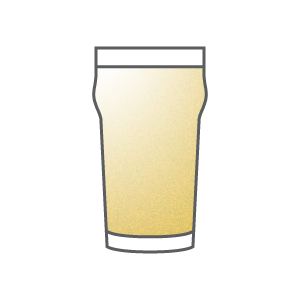
This glass is similar to the shaker pint glass but it’s slightly more fancy. It has a protruding ring near the top to help with handing and to develop a more substantial head than a shaker pint. By concentrating the aromas of the beer in the head, the first sip is more fragrant. This glass is best used for most American and English styles like Stouts, Pilsners, Brown Ales, and Porters.
ENJOY WITH
- Stouts
- Pilsners
- Brown Ales
- Porters
Sam Adams Perfect Pint
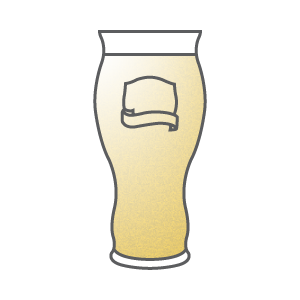
Specifically designed to hold Sam Adams Boston Lager, this glass offers beer lovers “a full sensory drinking experience.” The outward turn of the lip places the beer at the very front of a drinker’s palate to maximize the malt’s sweetness. The narrow top helps to retain the hop aroma and sustain the head. With thinner walls and a rounder shape, the right beer temperature is maintained and the aromas are gathered in a single place. Finally, the bottom of the glass features a nucleation site (laser etchings) that creates bubbles for a consistent aroma release.
ENJOY WITH
- Sam Adams Boston Lager
Snifter

Also used for brandy and cognac, this glass has a wide bowl, a tapered mouth, and a stem to help capture the aromas and volatiles of stronger beers. Their shape helps to keep all the aroma in and enhances the nose of malty, complex brews that are usually strong and high in alcohol (ex. anything that starts with Imperial or Double).
ENJOY WITH
- Imperial IPAs
- Imperial Stouts
- Barleywines
- Strong Ales
Stange

This glass originated in Cologne, Germany. It is most often used for Kolsch beer, a style native to Cologne, and it is designed to fit into a tray used by waiters at Cologne beer halls and pubs. The German word, stange, means “stick.” This glass is similar to a pint glass because it is narrow and cylindrical. However, it’s more slim than an average pint glass, helping to preserve the beer’s aroma and to amplify hop and malt nuances. In addition to traditional Cologne beers, the Stange is also used for Altbiers, Bocks, and more delicate beers.
ENJOY WITH
- Altbiers
- Bocks
- Czech Pilseners
- Lambics
- Rye Beers
Thistle

Similar to the Tulip glass, the thistle glass has a stem and a bulb-like bowl. However, this glass is a bit taller and is less curvy around the lip. It was specifically designed for Scottish Ales because Scotland’s official flower is a thistle. It’s also used for strong brews like Belgian ales, and Double IPAs. The bulb-like bowl lets drinkers swirl around the beer so they can help release the full aromas.
ENJOY WITH
- Scottish Ales
- Belgian Ales
- Double IPAs
Pilsner

The Pilsner glass holds 12 ounces of beer, making it smaller than some of the other glasses on the list. It has triangular dimensions (almost like a trumpet) to help capture the sparkling colors of Pilsners and other wheat beers while still retaining their head.
ENJOY WITH
- Imperial Pilsners
- Red Lagers
- Malt Liquors
- Bocks
Oversized Wine

This glass is best used for strong, high gravity beers and Belgian Ales. The size of this glass allows for headspace and the bowl helps to create an awesome nose. This glass works much like a Tulip or Goblet.
ENJOY WITH
- Double IPAs
- Imperial IPAs
- Dark Ales
- Belgian Ales
Weizen
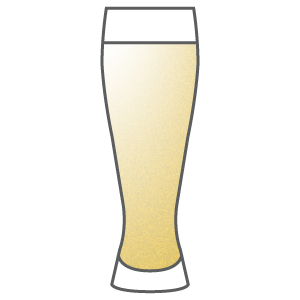
The Wheat Beer glass is much taller than a standard pint glass. It starts out skinny and widens slightly at the top and it has thin, lengthy walls to help showcase the beer’s color. This glass is designed to leave room for headspace, which is necessary for the fluffy head of wheat beers. The design also helps to lock in the banana aromas.
ENJOY WITH
- Wheat Ales
- Hefeweizens
- Dunkelweizens
Mug

Usually the glass of choice at beer halls, this mug is large, durable, and meant to hold a ton of beer. Since the main purpose of this glass is usually drinking large quantities with a group of friends, this glass doesn’t focus on bringing out the clarity, carbonation, or aroma of specific beers. It has a large handle for easy-gripping and it’s tough enough to take a good clink.
ENJOY WITH
- Amber/Red Ales
- Amber/Red Lagers
- Dark Wheat Ales
- IPAs
- Stouts/Porters
Seidel Mug

Once popular for its grenade-like appearance, this old-style glass nearly disappeared in the early 2000s. However, it is back in use. An old British tradition, this jug has dimpled sides, a wide mouth, thick glass, and a sturdy handle. It is believed the dimple pattern was introduced merely to use less glass in production. The mug’s thick walls help to keep it cool and the handle is great for easy gripping. Many like to drink from them because of their heritage and “old-school coolness.” Although they are back for now, not everyone is a fan. Some drinkers think the mug is too clunky and has poor head retention and bartenders have trouble storing them because they can’t be stacked.
ENJOY WITH
- Amber/Red Ales
- Amber/Red Lagers
- Dark Wheat Ales
- IPAs
- Stouts/Porters
Stein
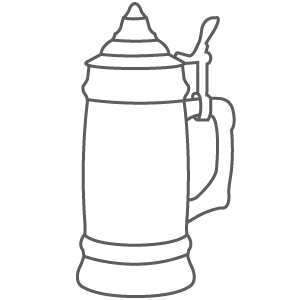
Often confused with a mug, the beer stein is the same shape but it has a hinged lid. Traditionally, steins were made with a variety of materials like stoneware, silver, wood, and porcelain. This glass originated because it was believed that a lid would make more drinking more sanitary and prevent the bubonic plague. Today, people still use these glasses but they are more like an ornamental or souvenir glass.
ENJOY WITH
- Brown Ales
- Red Ales/Lagers
- Stouts/Porters
- Malt Liquors
Goblet/Chalice

A goblet is delicate and long stemmed and a chalice is heavy and thick walled. Other than looking super majestic, this type of glass is great for head retention, deep sips, and analyzing aromas. Unlike other glassware, these glasses are found in a variety of sizes. They’re best suited for heavy, malty beers like German Bocks and Belgian Ales.
ENJOY WITH
- Belgian IPAs
- Belgian Strong Dark Ales
- German Bocks
TeKu
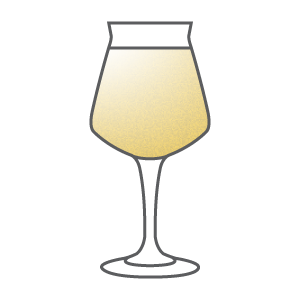
Designed by an Italian top craft beer brewer and a sensory analyst, the TeKu glass is supposed to improve the craft beer drinking experience. Although it was originally created and branded for the Baladin brewery, it quickly grew in popularity and is now widely recognized as one of the top beer glasses today.
The glass has a unique shape. It’s almost a hybrid of a long-stemmed wine glass but it’s designed to capture and release a beer’s aromas in its outward curve and thin glass. It’s been called the true glass for beer geeks.
ENJOY WITH
- Ales
- Lagers
- Porters
- Stouts
- IPAs
Flute

In addition to holding champagne, this glass’s long and narrow body ensures that beer’s carbonation doesn’t dissipate too quickly. It also showcases the carbonation and color and helps to quickly release volatiles to provide a more intense upfront aroma. Sometimes the stem is a bit shorter than a regular champagne flute, but not always. Use this glass when pouring a Pilsner or a beer that emulates wine.
ENJOY WITH
- Wild Ales
- Bocks
- German Lagers/Pilseners
- Lambics
Sampler/Tasting

These types of glasses are used for, you guessed it, sampling and tasting. These glasses come in different sizes and shapes and they hold only a small amount of beer so you can sample multiple beers without getting intoxicated. You’ll often see breweries using these types of glasses as well as your local pub.
ENJOY WITH
- Ales
- Lagers
- Porters
- Stouts
- IPAs
13 Reasons Your Bar Could Fail a Health Inspection
Here are 13 reasons your bar could fail a health inspection, and how to avoid them.
If you’ve worked in the industry, you probably know what it’s like to prepare for the dreaded “health inspection” day. You run around scrubbing all visible surfaces, telling everyone to wash their hands, and checking the temperature of every fridge.
Your bar must pass every health inspection. If not, you risk ruining your reputation, getting people sick, and getting closed down for good. Although this can be a bit stressful, it’s important bars and restaurants are regularly inspected to ensure staff and customers don’t fall victim to foodborne illness.
Start Your Free Trial With Bevspot Today!
You may not consider “food safety” a pressing concern if you’re a bartender mostly dealing with drinks, but food safety isn’t just owned by the kitchen it is a key component of bar managing. If you haven’t had the proper training, aren’t aware of safe practices, or don’t have a proper health inspection checklist, your bar might not just fail an inspection; you could potentially harm a customer.
1. You use a glass to scoop ice
In a busy bar scene, it might seem like the quickest way to get some rocks in a glass. But if you knew the potential consequences, you’d think twice before taking this short-cut.
Using a glass to scoop ice is harmful in two ways:
1) if the cups not washed properly, it could contaminate all of the clean ice
2) if the glass breaks or chips, it can get into your patron’s drink or fall into the ice bin.
To eliminate these two health risks, use a clean ice scoop to put ice in drink glasses. If there ever is a suspected problem with the ice, be proactive and throw hot water on the entire batch and replace it.
2. You pick up glasses by the rim
Never pick up glasses by the rim. By doing so, you’re spreading any bacteria that might be on your hands straight into your customer’s mouth. Make sure to hold the glass by the bottom or by wrapping your hand around the side. If you’re serving wine, be sure to hold the glass by the stem. Be wary of this, not only does this bad habit put your customers at risk, but many people keep an eye out for this when they go to bars and restaurants. You reputation is also important.
3. You don’t wash your hands regularly
You should be washing your hands just as often as the chef. Think about the sticky cash tips you pick up and how many dirty glasses and you’re constantly touching. They’re probably covered with viruses, bacteria, and other unknown substances — yuck.
If you don’t wash your hands regularly, you could be spreading these germs to others and putting yourself in harm’s way. Make sure there’s antibacterial soap and a designated hand-washing station for bar staff. Each handwash should last for around 20 seconds and should occur before a shift, multiple times during a shift (especially if you touch their hair or face), and after a shift. Although bars are often crunched for time, hand-washing shouldn’t be overlooked if you want to keep your staff and patrons safe.
4. You use a dirty towel to sweep crumbs off the bar
Just because something looks clean, doesn’t mean it is. Bar surfaces need to actually be clean in order to prevent illness and pass a health inspection. This means, you can’t just take a towel and smear contaminants around, you need to sanitize the bar to kill bacteria that could potentially harm a patron.
Remember, the bar is the center of your business. If your bar top isn’t disinfected, menus, silverware, napkins, and other items can potentially be contaminated, putting your customers at risk.
5. You stack your glassware on the bar right-side up
First of all, glasses really shouldn’t be stored on the bar. If the storing and the drinking area are the same, it leaves the potential for cross contamination. If you have the room for it, it’s better to store your glasses on racks or shelves. This will keep them separated and prevent customers and bar staff from knocking them into drinking/eating areas and the ice bin. Store your glasses upside down in order to prevent dust from collecting. If storing your glasses on the bar is your only resort, use storage mats to prevent glasses from getting chipped.
6. You don’t wash glasses properly
Serving customers a drink in a dirty glass is a major no-no. Not only does it look bad, but it can also ruin a good beer and potentially get them sick. Staff should be trained to wash glasses at a minimum of 171 degrees Fahrenheit and dish soap, or with chemical sanitizers in a low temperature dishwasher. Once glasses are washed, make sure to double check for remaining lipstick stains, they can be pretty resilient. It’s also important to make sure there is no remaining soap or food fat on the glass surface, especially when serving beer because it can ruin a beer’s head.
7. You don’t clean draft beer lines
Beer lines don’t just clean themselves. You need to clean your beer line and faucet parts weekly, or every time you switch out a keg in order to flush out the old beer and make way for the new. If you don’t clean your draft lines, you’re potentially leaving mold, bacteria, yeast, and dead fruit flies in there. Not only is this gross and potentially harmful, it’s also detrimental to the the taste of your beer.
8. You lick your fingers to pick up a napkin or a receipt
This is a bad habit many of us have, and we should all work on breaking it. But it’s even more important for bartenders to stop this bad habit in its tracks. By licking your fingers, you’re transferring germs from your mouth to your customer’s napkin. Plus, anything that your fingers have touched is going in your mouth — ew.
9. You offer giant bowls of bar snacks and pour whatever’s not eaten back into the storage bin
People love free food (especially when a few cocktails are involved). It’s okay to have these goodies for your customers, but it’s important to think about what snacks you choose, how they’re presented, and how they’re rotated out. First, choose snacks that can stay out at room temperature for long periods of time like pretzels and popcorn. Second, consider giving personal snacks to patrons when they take a seat at the bar instead of simply leaving out large bowls for everyone. An alternative would be to have a large bin and allow customers to scoop their own portion into plastic cups. And most importantly, whatever customers don’t finish should be discarded, NOT put back into the storage bin.
10. You keep all your garnishes at room temperature
Nowadays, garnishes are a lot more elaborate than just a lemon or a lime wedge. Unconventional food items like shrimp, melon, and salami have been making their way on cocktails across the country. And while you can leave the common garnishes at the bar for the majority of the day, there are some that need to be stored in a refrigerator up until use to eliminate the chance of foodborne illness. You also need to check the temperature of your fridges regularly to ensure they are holding food at between 32 and 40 degrees.
11. You only use one cutting board and you never wash it
First thing’s first, wash your cutting boards! Also, make sure you’re using separate ones for different types of garnishes. For example, prepare shrimp and limes separately. Not only is this good for preventing foodborne illness, but also allergic reactions. If someone’s allergic to shrimp and a lime has been cross-contaminated by it, you risk a serious reaction if you add it to their cocktail.
12. You don’t wash garnishes before cutting them
Rinsing garnishes before cutting them is crucial for getting rid of all the bacteria. Even if you’re dealing with lemons and limes, your knife can pick up bacteria and spread it inside while you’re cutting. When you’re rinsing your garnishes, be sure to use a kitchen sink that isn’t filled with dirty glasses.
13. You keep unused garnishes for the next day and don’t wash the garnish holder
Garnish holders are often placed directly on the bar, within the reach of customers. Once people start getting to their third or fourth cocktail, they might decide they fancy a cherry and reach into the garnish holder when you’re not looking. Also, most garnishes are sweet, which means flies could be attracted to their scent. If you reuse garnishes or fail to wash your garnish holder at the end of every night, you’re putting customers at risk.
As you can see, there are a number of different areas to pay attention to when it comes to keeping your staff and customers safe. Use your best judgement and keep these 13 mistakes in mind in order to avoid dangerous slip-ups in health inspection. This way, you’ll get that health inspector in and out the door with nothing but good things to say.
Make sure you’re always ready for a health inspection visit with our free handy checklist that goes through every step-in detail!
Schedule 15mins to chat with a product specialist
Start a FREE Trial Today! BevSpot offers full product education and account setup for all customers! No card Information needed!
Customer Stories: East Coast Tavern Group
When we meet people who truly understand this industry, the connection just clicks. With so many small details and kinks to work out, it takes time to build a working operation. Cedric Adams, Operations Director of Boston’s East Coast Tavern Group (ECTG), understands what it takes to run a well-oiled machine. With over 20 years experience in the hospitality industry, he’s witnessed firsthand the growth of technology and data in the industry, has seen what works and what doesn’t, and knows that in an ever-evolving industry, one thing remains paramount—the importance of surrounding yourself with a strong team.
As I sat in a dimly lit booth across from Cedric at 6B Lounge, it quickly became clear why this restaurant group is expanding so rapidly—it’s backed by people who understand what it takes to build the right team and implement the right tools.
Beverage Management
Prior to BevSpot, ECTG had implemented an inventory management system that just didn’t improve the group’s efficiency behind the bar: “Our original solution worked for what it was, but its time had passed. Needing our own individual handheld system and allowing for only one person to take inventory when I’ve got two other people running around the bar—it wasn’t efficient.” Adams knew there had to be something better out there: “It’s not just about using technology. It’s about ease of use.”
With an engineering background and a love of numbers, Adams knows the value of hard data and the insights it can provide for his industry. About a year ago, when 6B Lounge’s Bar Manager Oran McGonagle presented Adams with BevSpot—a technology solution that would streamline bar management operations while also providing the right data—it was a no brainer to test it out at one location:
“With BevSpot, we’re driving down, we’re looking at costs, when we build a drink, we can literally build a drink in BevSpot, and then at the end of the year we can go back and look at the variance and say ‘we sold this.’”
“Unlike our previous solution, it’s on your phone and everyone can help out with doing inventory.”
Building the Right Team
When I asked Cedric about his role in the process of software implementation, and what advice he would give to future Operations Managers, he didn’t hesitate to give all credit to his managers behind the bar. As someone who chose hospitality over a Manufacturing Engineering career path, realizing, “as much as I loved numbers, I loved people more.” Cedric can’t speak enough about how people skills and customer service really drive his business:
“If someone asked me to describe my job, you know what my job is? Talent Acquisition. You’re only as good as the people around you, and that is the most important thing. I’m spoiled, I have a lot of really great managers. My managers do amazing things every day. They do all the work. These guys literally put in the work—face to face with customers, making friends, everyday. I only get to do the stuff I do because of the people who work for me. I’ve got good people, I’ve got good chefs, and that’s what it comes down to.”
And that is certainly what it came down to when the time came to consider BevSpot as a solution. I was curious about the process Cedric went through when considering new software solutions, and Cedric had only two words for me: Oran McGonagle.
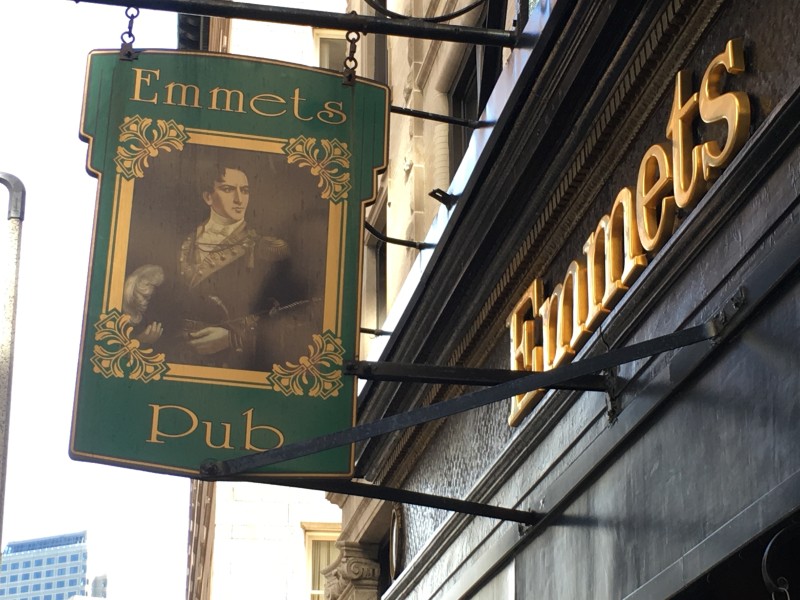
“He’s the best. He is the reason that this is successful. He’s very smart and a good operator, and he saw the benefits right away. I said ‘if he thinks it’s good, I need to look at it,’ because the truth is he’s right 99% of the time. And when you have a product that someone can pick up and use right away—it’s pretty easy to get on board.”
Cedric, who spent 17.5 years bartending at a Boston staple, Silvertone, says, “I’ve worked for some really good people, and that’s half the battle.”
From the Perspective of a Bar Manager
So with such high praise to 6B Lounge’s Bar Manager, Oran McGonagle, I went straight to the source to learn about his process and what happened when first introduced to BevSpot.
“Ultimately, our goal was to move away from a piece of paper and work faster. That was not happening with the tool we were using.”
Becoming increasingly annoyed with the incumbent system, Oran pushed for giving BevSpot a go, “It was exactly what I wanted and exactly what the company needed.” He also notes how easy it is for him to train his team to use BevSpot (we’re sensing a theme with teamwork in this group and are happy that we can help!).
Not only has BevSpot taken about 70% off of Oran’s inventory time, but he has not missed a single one of his monthly performance-based bonuses since implementing BevSpot.
Sounds like Oran got a lot of time back in his days. So how is he spending that extra time?:
“I do a lot more research so I can make sure I’m carrying the best products at the best prices. My relationships with my reps are a lot more of what can we do rather than what are we doing. And I’m able to change the menu a lot more often—it used to be seasonally but I changed it just the other day to try a new beer.”
We’re happy to help and love partnering with people who understand the importance of streamlining operations with great technology! Thanks for chatting with us, Cedric and Oran.
What’s the Best Type of Pour Spout?
What’s the Best Type of Pour Spout?
On the surface, pour spouts might not seem like a fascinating topic. But the type you use, your cleaning method, and the pour spout training you provide to your staff can affect your bottom line. Essentially, if you don’t put enough thought into pour spouts, you could be wasting a lot of money.
Start Your Free Trial With Bevspot Today!
Now do we have your attention?
If you work in the bar industry, you’re surrounded by pour spouts. They’ve been there for you since day one, on almost every bottle. You know that pour spouts are essential for speed and accuracy, helping you avoid over-pouring, spillage, and wasted time. If you’ve ever tried to pour without one, you’ve likely seriously botched a cocktail and wasted product.
Depending on your bar, they might all be shiny metal and rubber, a medley of plastic multi-colored spouts, or a combination of the two. When you need to replace one, you might simply swap it with whatever’s convenient. But what if this haphazard method is costing you money and wasting bar inventory?
You may not have thought about them critically before, but it’s time to get serious about pour spouts! Here are 10 types of pour spouts you need to know.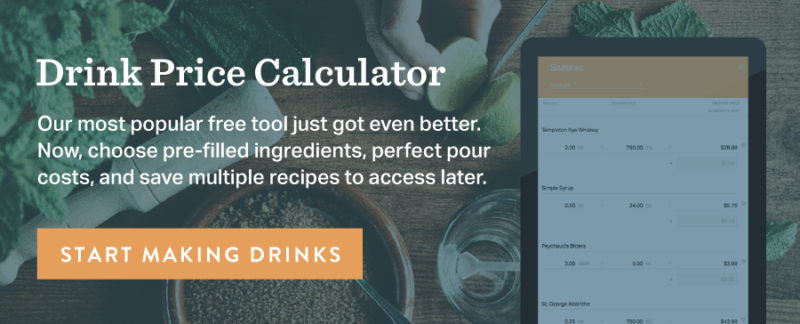
Types of Pour Spouts
Technically, there’s no such thing as the “best pour spout.” If your bar is a high volume city sports bar, a quieter craft cocktail bar, or a divey college bar, you’ll likely have different priorities when it comes to pour speed, durability, appearance, and precision. We’ve compiled a list of common pour spouts and their different features.
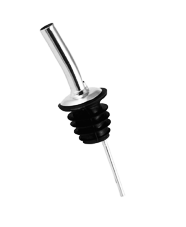
1. Standard Metal Pourer
Price: $6-13/dozen
Very commonly used, the standard metal pourer helps bartenders prepare drinks with accuracy and speed. The long spout reduces spillage and allows for precise, high-flow rate pours. The standard metal pourer usually features a rubber seal. Keep in mind that it doesn’t include a built-in mechanism to prevent insect or dust contamination.
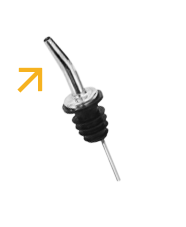 2. Tapered Metal Pourer
2. Tapered Metal Pourer
Price: $6 -13/dozen
A tapered pourer offers accuracy, control, and a consistent pour speed every time. It has a medium flow-rate and it usually has a rubber seal. Despite its popularity it is susceptible to fruit fly and other contaminants.
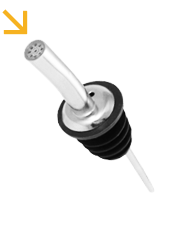 3. Screened Metal Pourer
3. Screened Metal Pourer
Price: $10-25/dozen
This pourer is not as commonly used. It has a lower flow rate sometimes about ½ to ⅔ the rate of standard pourers. The screen can make it difficult to pour more syrupy or creamy spirits such as Kahlua, Chocolate Liqueur, or Midori. If pourers slow you down, they can cost you money. Bartenders also often report that the screens sometimes fall out into customers’ drinks, they’re also a bit difficult to clean. The good news about screened metal pourers is they’re impervious to insects. If you use these spouts, put them on infrequently used sweet liqueurs that might be especially attractive to bugs.
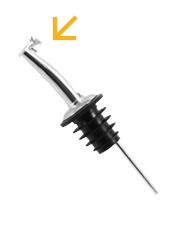 4. Metal Flap Pourer
4. Metal Flap Pourer
Price: $8-20/dozen
If you’re looking to keep out debris and bugs, a pour spout equipped with a built-in flap might be the way to go. For the most part, users have reported no effect to the pour speed. However, some thicker, stickier spirits can sometimes get stuck on the flap and slow the pour. Some flaps open automatically when you tilt the bottle down and others need to be manually opened with your thumb.
** Note: metal pourers are widely deemed the “best looking” pour spouts for presentation of alcohol behind the bar
5. Standard All-Plastic Pourer
Price: $2-6/dozen
Plastic pourers come in a variety of colors and are usually the cheapest type of pourer. Since they’re made using one piece of molded plastic, they can be pretty durable. These pourers are very common behind the bar. They generally perform well but tend to “hiccup” if you turn them upside down too quickly to pour. With plastic pourers, you have the ability to choose from a variety of colors. Some bars go for the more “professional look” by putting the same colored spouts on every bottle. Others use the color nozzles to help bartenders quickly identify alcohol types or they choose to mix and match colors randomly. As a reminder, these are not screened so they are susceptible to contamination.
6. Chromed Plastic Pourer
Price: $7-13/dozen
Many bartenders prefer this type of pourer for its look and control. This pourer features a longer nozzle and a larger hole for a fast pour speed. To slow down the flow rate, you can use your thumb to cover the breathing hole. This type of pour spout is also easy to clean but does not include a mechanism for keeping bugs at bay.
7. Screened Plastic Pourer
Price: $3-12/ dozen
If your goal is to keep out the fruit flies but still retain a fast pour speed, a screened plastic pourer might be your best bet. You can also purchase them in a variety of colors! On the flip side, they need to be cleaned frequently and they’re not very well suited for thicker syrupy spirits such as Bailey’s Original Irish Cream. Controlling the speed of the pour can also be difficult because there is no separate vent.
8. Cap-OnⓇ Pourer
Price: $0.79/dozen
Another way to avoid evaporation and contamination is to use Cap-OnⓇ Liquor Pourers. These pourers have great accuracy and because they’re leveled off, you can still store your liquor with the cap on. The company suggests you throw out the pourer with each emptied bottle, but some bartenders explain they can get them out and recycle them with a V-RodⓇ bottle opener. Warning, some bartenders report that the cap will not go back on for certain liquors with shorter caps such as Maker’s Mark if this pourer is used.
9. Ball Pourer
Price: $25-50/dozen
Although the idea is headed in the right direction, precision ball pourers often get a bad rap among bartenders. They’re designed to allow pours of 1oz to 1.5oz to administer strict quantity control in order to reduce liquor costs and provide consistency. This might be a decent method for pouring with precision and keeping track of what leaves the bar and it can prove useful in alcohol tastings. Using a ball pourer also allows bartenders to use both hands so they can be pouring in the mixer and the liquor at the same time, which saves time. Sounds great right? That’s not always the case. Moving to these pourers might make bartenders feel like management doesn’t trust them, and ball pourers can restrict bartenders from pouring a “dash” or a “splash” when a cocktail recipe calls for it.
10. Computerized Pourer
Price: Usually need to request a quote (tend to be pretty expensive)
Computerized pourers either distribute a certain amount like ball pourers or they free pour. Regardless of the pour method, the computer pourer provides extremely strict inventory control, calculating, and consecutive reporting. Usually, these pourers are linked wirelessly to the POS or another digital system so there can be real-time analysis. Although these might seem like a smart way to decrease liquor spend and keep track of data, it’s important to keep in mind that some bartenders feel these are invasive and overbearing. Also, when customers see a computerized pourer used behind the bar, they might feel like the experience isn’t as authentic or personal.
Cleaning Pour Spouts
Pour spouts are supposed to allow for a smooth, even pour, but if the air vents become blocked, liquid won’t come out of the bottle. Over time, pour spout vents can get clogged, especially those used to pour liquor with high sugar content. To keep your pour spouts working their best and to help them last longer, you should clean and check for/replace broken ones regularly. If you need to clean them, there are a number of different ways.
Some pour spout companies such as Precision Pours suggest you use a special $45-$50 pour spout cleaner that only uses warm water and eliminates the need for soaking or using detergents.
If you don’t want to purchase a new tool you can soak your spouts in warm, soapy water for 15-20 minutes. In order to wash the inside of the spouts, shake them to get the soapy water inside and conclude your wash by rinsing them in cold water. Be sure to avoid using sanitizers and bleaches, dishwashers, and overly hot water.
Pour Spout Training
Many bartenders report that metal pour spouts tend to pour at the same rate, but plastic ones don’t have the same consistency. Ball pourers, if quality, will automatically measure one ounce. The bottom line is different pour spouts have different pour rates. It’s important to keep in mind that no matter what pour spout you choose to put on your bottles, your staff needs to be trained on how to use them (especially if they’re free pouring without a jigger).
In order to learn how to properly pour an ounce, bartenders should practice pouring an ounce into a one-ounce jigger or a one ounce marked glass using some type of counting system. Depending on their preference or the type of pour spout they use, they might want to count to either three or four (the most common method) per ounce or they can make up their own counting scheme – as long as it works!
In order to ensure bartenders’ free pours are accurate and consistent, avoid switching out pour spouts once you’ve chosen the right one for your bar, and you’ve trained your staff. If you randomly change out pour spouts with whatever is the cheapest or most easily available, your bartenders might take a while to get used to the pour speed, or worse yet, they might continuously overpour without either of you knowing it. Even if you don’t switch up pour spouts, if your bartenders are free pouring, they should be frequently tested to see if their pours are accurate.
As you can see, pour spouts are more than meets the eye. You want them to look good, work properly, and pour consistently. Carefully consider which pour spouts will work best for your bar, be sure to constantly clean them, and properly train your staff how to pour one ounce every time. For more helpful bar management tips, check out our ebook!
Schedule 15mins to chat with a product specialist
Start a FREE Trial Today! BevSpot offers full product education and account setup for all customers! No card Information needed!
The Anti-Tipping Movement and What it Means for You
You’ve probably heard about the anti-tipping movement that’s causing controversy in restaurants and bars across the country.
If you haven’t, here’s everything you need to know.
A movement to eliminate tipping practices is gaining popularity in some of the country’s best restaurants. However, it comes layered with argument, shots fired from both corners.
The question of “how much should I tip?” has hovered at the end of our meals since the early 20th century. Bar and restaurant tipping guidelines are instilled in us from a young age, and gratuity is a large part of the way the American hospitality industry works. But this industry has struggled with minimum wage issues for years, and now people are questioning whether or not our model is the right one.
So, what’s this movement to ban tipping all about?
Let’s find out.
The Anti-Tipping Team
Believe it or not, when it first originated in the U.S., tipping was frowned upon and considered undemocratic. After repeated efforts to reject gratuity practices, they slowly transformed into an industry custom, but now some opinions are coming full circle.
Advocates of the no-tipping movement claim that restaurant economics are broken, and that the elimination of tipping would be better for both customers and employees. Rather than allowing patrons to tip only the front-of-house staff, they’re now building gratuity into the menu to develop fair wages for all employees.
Here’s a quick video that explains the argument against tipping.
The pioneers of this movement are San Francisco and New York City, and, more specifically, one of New York’s well-known restauranteurs, Danny Meyer. Meyer’s company, Union Square Hospitality Group, owns a variety of establishments, from the high-end Gramercy Tavern to the Shake Shack empire.
Meyer claims that tipping is unfair to some staff and the elimination of it will stop unjust issues like unfair wages, racial discrimination, and sexual harassment in tipping. Meyer also claims that providing good service should be expected as part of the job. “It’s troubled me for 21 years that the tipping system is antithetical to creating a real profession for people who take their jobs seriously,” he told The Telegraph. “You don’t tip your doctor if they do a good job. You don’t tip the airline pilot if the plane lands.”
To maintain a form of feedback and be able to reward his staff through raises and promotions (rather than tips), Meyer plans to offer an online rating system.
With New York State raising the minimum wage to $15 by 2018, some establishments are abandoning traditional tipping guidelines to help manage labor costs (with a fair wage for all employees, particularly back-of-house) and attract talented staffers with the promise of a consistent wage.
Several of New York’s Michelin-starred restaurants are following, adopting these “service included” models: Eleven Madison Park, Per Se, Masa, and The Chef’s Table at Brooklyn Fare.
A spokesperson from Masa said that adopting a no-tipping policy will allow the restaurant to “maintain talent across the board” and provide its employees with “a more consistent and reliable paycheck.”
“Reflecting the Japanese custom, exceptional hospitality is an integral part of the Masa dining experience and is provided to every guest.”
But, of course, these high-end restaurants are hardly reflective of the average American establishment—they can afford to experiment while still running a successful bar or restaurant. And the raising of both employee wages and menu prices through built-in gratuity leads us to ask the question, “How much will everything cost now?”
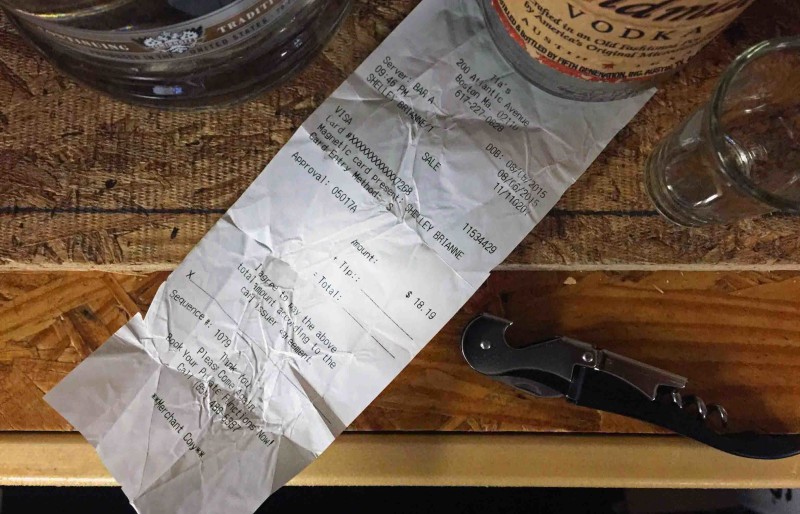
The Pro-Tipping Perspective
Not surprisingly, a large majority of customers and industry employees don’t want restaurants to adopt no-tipping policies.
This argument is backed by several claims:
- The elimination of tipping will result in bad service everywhere.
- Including gratuity means stealing money from servers to give to cooks.
- Owners will pocket this built-in gratuity and will not pass on to employees what legally should be theirs.
- Many employees won’t earn as much on an hourly wage as they could under tips.
- America’s tipping practices have always, still do, and will continue to work.
According to Horizon Media’s Finger on the Pulse Survey, the majority of American consumers aren’t ready to accept tipping bans across the country. However, the study states, Millennials and Gen Z consumers are more open to change.
With tipping averages and the cost of dining out so high, it’s no surprise people are rejecting the idea that they’re paying more for their meals, even if gratuity-included menus do end up costing the same. New York City is currently ranked highest in the country, at $48, for average meal prices when dining out. Boston is close behind at $43. Many owners are afraid that raising menu prices to include tipping will scare away customers.
It’s also been said that most consumers identify tipping practices as their right to pay a fair amount for the service they believe they receive. And it’s understandable that people aren’t yet fond of the idea of someone taking this away.
And as for the servers, those who currently earn a good wage from tips aren’t ready to give up that income for the promise of $15 an hour—it may be a steady wage, but some say it just can’t beat the tips.
So, what does this mean for bars and restaurants around the country?
The reality is that the majority of employees in the food and beverage industry rely on tips to survive. And until each state implements an acceptable living wage, just as New York is doing, this will likely continue as the reality.
Some argue this is not a sustainable model for an industry to rely on, and, from an economic standpoint, business owners should be able to afford to pay their staff instead of expecting customers to pay staff for them. “This faulty business model continues to achieve the illusion of sustainability, when this is not the case,” says bartender Erick Castro.
But how should an owner be expected to turn their business on its head after so many years of operating under this model? Well, at least for now, bars and restaurants around the country have no need to worry. The anti-tipping movement is gaining traction, yes, but it’s a slow progression that, for now, is only being adopted by high-class restaurants who can afford to experiment.
Regardless, it’s an interesting industry move that we’ll be watching closely. Check back with BevSpot as the story progresses!
What do you think? Can a balance be found between a better minimum wage and optional gratuity? Or are you firmly planted on one side of the argument?
Want to know more? Head to our restaurant and bar industry news page for the latest stories.
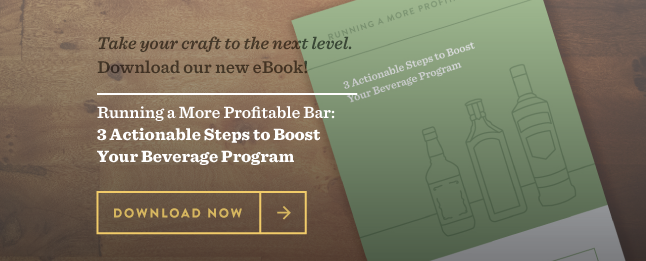
Glassware Guide for Wine Enthusiasts
According to some professionals, even if you expertly uncork a wine bottle and perfectly pour a glass, if you’re using the wrong glassware, you’re limiting a drink’s potential. Over the years, glassware has evolved to enhance each individual type of drink and improve the overall drinking experience.
In addition to expert opinion, scientific studies have found a correlation between glass shape and a drink’s presentation, flavor, aroma, body, temperature, and even the way people drink it.
There are hundreds of different glass types so you may be thinking, “How can I possibly stock every option and memorize every single pairing?”
Don’t worry, we’re here to help! Check out the list below to see what glassware experts suggest using for each beverage. Also, learn more about how to Price your individual types of wine glasses in order to ensure success. BevSpot’s bar inventory app specializes in drink and food and helps you manage a successful business, try and get set up for free today.
Start Your Free Trial With Bevspot Today!
The Basic Wine Glass
You may know that wine goes in a wine glass. But, do you know why?
A wine glass is made of four basic parts: the rim, bowl, stem, and foot.
The size of the rim and the thinness of the rim’s material can affect the wine’s taste and temperature. The stem allows people to hold their wine glass without transferring heat from their hands, helping to maintain a wine’s intended serving temperature. A wine glass’s bowl helps to capture and spread a wine’s aroma and the foot allows the drink to stand upright.
If you’ve got the basics down, you’re in good shape. However, although their main parts are similar, not all wine glasses are exactly the same. If you’re looking to provide customers with a top-notch experience, the type of wine you’re serving should dictate which specific type of wine glass to use.
Red
When you’re serving a nice red, you should use a larger wine glass with a full, round bowl and a large opening. A red wine glass should have a large surface area to give the wine more contact with the air and allow for more flavor and aroma to release. It also provides a customer with enough space to dip his or her nose into the glass to get a good whiff!
If you want to go a step further than a simple red wine glass, you can stock your bar with Bordeaux, Burgundy, Merlot, Pinot Noir, Shiraz, and/orPort glasses.
Bordeaux
The Bordeaux glass is designed for heavy, full-bodied wines and its bowl is smaller than a standard red wine glass. To maximize the flavor, the glass is taller, so the wine proceeds directly to the back of the mouth. You can use this glass for syrah, cabernet sauvignon, merlot, and other rich, strong wines.
PERFECT PAIRING
- Cabernet Sauvignon
- Cabernet Franc
- Syrah
- Merlot
- Malbec
Burgundy
The Burgundy glass is designed for lighter, full-bodied wines like Pinot Noir. This glass is shorter than the Bordeaux glass but it has a bigger bowl so the wine is directed to the tip of the tongue so the drinker can taste the more delicate flavors.
PERFECT PAIRING
- Pinot Noir
- Barbaresco
- Baralo
- Barbera
- Red Burgundy
Pinot Noir
The Pinot Noir glass also has a tapered lip and a wide bowl, but the stem is shorter compared to other red wine glasses.
PERFECT PAIRING
- Pinot Noir
Shiraz
The Shiraz glass stands out from other wine glasses because it’s significantly tapered inwards, it has a wide base and bowl, and it has a mid-sized stem. These features are supposed to first present fruit aromas, followed by the tannin flavors.
PERFECT PAIRING
- Syrah
- Amrone
- Barbera
- Atelier Barolo
Port
The Port glass features a small, slim bowl and a shorter stem. The smaller bowl size makes it so the strong smells don’t overwhelm the pepper, black currant, and oak flavors. The glass is designed with a short stem, so the drinker’s hand warms the wine as he or she sips, helping to enhance the flavor.
PERFECT PAIRING
- Port
- Madeira
- Colheita
- Noilly Prat
- Vinsato
White
The bowl of a white wine glass is more vertical, has more of a “U” shape, and a generally smaller mouth area than a red wine glass. Because it is usually served cold, this glass shape allows white wine to maintain a cooler temperature while still allowing aromas to be released. The wine also aerates less so it retains more delicate and lighter notes.
Like red wine glasses, there are a variety of white wine glasses. If you want to stock your bar with a variety of white wine glasses, consider using Montrachet, Sauvignon Blanc, and/or Riesling glasses.
As a side note, keep in mind younger white wine is usually best served in a white wine glass with a slightly bigger opening so the wine is directed to the tip and the sides of the tongue to accentuate its sweetness. More mature white wines are usually best served in taller and straighter glasses so the wine is dispensed to the back and the sides of the tongue in order to taste the bolder flavors.
Chardonnay
The white wine glass described above is also referred to as a Chardonnay glass, which is sometimes considered the “all-purpose” white wine glass because it is versatile and appropriate for any dry, light wine such as Pinot Grigio.
PERFECT PAIRING
- Chardonnay
- Pinot Grigio
- White Burgundy
- White Bordeuax
- Pinot Blanc
Montrachet
The Montrachet glass is used to improve Montrachet Chardonnay. The glass has a larger bowl so the drinker can better smell the complex aromas. It also has a wider rim to direct the wine to the edges of the tongue, so the wine’s sour and acidic flavors are accentuated.
PERFECT PAIRING
- Montrachet
- White Burgundy
- Corton-Charlemange
- Meursault
Sauvignon Blanc
Another white wine glass is the Sauvignon Blanc glass. This type of glass is designed for more fruity white wines. This glass is tall and it has a slender bowl to help focus the floral and fruit aromas. Its narrow mouth helps deliver the aroma straight to the nose and spotlight the front of the tongue. In addition to Sauvignon Blanc, this glass can also be used for wines like White Bordeaux or Loire.
PERFECT PAIRING
- Sauvignon Blanc
- White Bordeaux
- Chenin Blanc
- Fume Blanc
- Loire
Riesling
The Riesling glass is smaller, taller and narrower than a typical Chardonnay glass. This helps to keep the fruity aroma at the top of the wine glass and it directs the wine to the back of the mouth, so the drinker isn’t overwhelmed with sweetness.
PERFECT PAIRING
- Riesling
- Zinfandel
- Sauvignon Blanc
- Gruner Veltliner
Sparkling
Sparkling wine (Asti, Cava, Champagne, Prosecco) should be served in an upright glass that is narrower than an average wine glass in order to maintain the carbonation and flavor. Depending on the type of sparkling wine you serve and your customer’s personal preference, you may want to stock Coupes, Champagne Flutes, and Champagne Tulips.
Coupe/Saucer
The oldest type of champagne glass is called the Coupe or the Saucer. This glass was most popular during the roaring 20s and it has a stylish, wide, and shallow bowl. Although it is often used for its vintage look, this style of glass is not as popular as it once was because it is not able to capture the qualities of today’s champagne. Due to its shallow bowl, the bubbles and the aromas dissipate quickly.
PERFECT PAIRING
- Champagne
- Cava
- Franciacorta
- Prosecco
Flute
Both classic and classy, the Champagne Flute is a popular choice for serving sparkling wine. Contrary to the Coupe, due to its design, the Champagne Flute successfully delivers fizz to the senses. The glass features a rough bead at the base,which causes the carbon dioxide bubbles to congregate and rapidly rise. This type of glass is great for younger wines. However, it may limit the complex flavors and aromas of older wines.
PERFECT PAIRING
- Champagne
- Cava
- Franciacorta
- Prosecco
Tulip
The Champagne Tulip is similar to the Flute, but it has a larger bowl space. It gets its name because it’s shaped like a tulip flower with a slim base opening into a wide bowl and narrowing slightly towards the aperture. Much like the flute, this design allows for lots of bubbles, but because the Tulip has a larger aperture it helps the bubbles hit the right regions of the tongue instead of going up a drinker’s nose. This larger opening also allows for more aeration and thus more flavors and aromas.
PERFECT PAIRING
- Champagne
- Cava
- Franciacorta
- Prosecco
Schedule 15mins to chat with a product specialist
Start a FREE Trial Today! BevSpot offers full product education and account setup for all customers! No card Information needed!
For more info on drink pricing, bar inventory, management techniques, and kitchen inventory, stay tuned to the BevSpot blog. You’ll get notifications when we post new articles, as well as exclusive access to our industry tools and guides.
21 Bar Industry Blogs You Should be Reading
21 bar industry blogs to follow
When it comes to creating a craft cocktail or running an efficient bar, there are variety of online resources available. But if you’re in the bar industry, navigating your way through hundreds of websites probably isn’t the best use of your time.
At BevSpot, we appreciate quality info and great writing. If you’re looking for some cocktail inspiration, if you want an expert’s opinion on the newest craft beer, or if you have a thirst for other alcohol related info, we suggest you check out these 21 bar industry blogs.
1. A Bar Above
Thirteen years ago, a young bartender in Northern California was struggling to learn craft bartending skills. He stumbled through old books and self-taught himself through trial and error. In 2012, he and his wife decided to create a website dedicated to teaching bartenders the necessary skills. This way, other bartenders could fine-tune their skills without having to spend years behind the bar.
Purpose: to help bartenders and enthusiasts learn the art of craft bartending and to provide bar education
Average frequency: 4 articles/week
Types of content: cocktail recipes, podcasts, bar business/bar career blog posts
2. Liquor.com
Liquor.com is a digital publication dedicated to good drinking and great living. They consider their publication to be their reader’s experienced drinking buddy who knows what to drink where, when to stir and when to shake, when to shoot and when to sip, and when to splurge and when to save.
They’ve won multiple awards such as the 2012 Tales of the Cocktail Spirited Awards for Best Cocktail Writing and Best Cocktail Author, and the 2013 James Beard Award for their “How to Cocktail” video series.
Purpose: to entertain, inspire, and educate enthusiasts and the merely curious about cocktails and spirits
Average frequency: 6 articles/week
Types of content: cocktail recipe library, spirits brand directory, bar guides, videos, lifestyle articles, slideshows, guides
3. Buzztime
Buzztime is a company that produces interactive entertainment for bars such as bar trivia, digital cards, and sports games. Their blog is dedicated to helping the bar industry in a variety of areas such as promoting, operations, and customer service.
Purpose: to give bars tips for improving their business
Average frequency: 1 article/week
Types of content: marketing your bar, industry trends, bar promotion, bar and restaurant operations, customer service, social media, bar entertainment
4. Nightclub & Bar
For more than 30 years, Nightclub & Bar has been engaging beverage decision makers and helping them grow. They provide bar managers with the tools they need to grow their businesses and consider themselves the go-to resource for the on-premise professional.
Purpose: to provide users with the most current information in the industry and offer promotion ideas, operational best practices, expert advice, and recipes
Average frequency: 26 articles/week
Types of content: cocktail recipes, operations, training & management, promotions, news, top rated lists, awards, bartender of the month
5. Stir and Strain
A “cocktail scratch pad,” this blog’s author, Elana, is constantly creating and testing cocktails. She’s been running the blog for 5 years and is a big believer in creating her own bar syrups, garnishes, and bitters. Her blog was a finalist for Saveur’s 2014 and 2015 Best Cocktail Blog and it was featured on Serious Drinks list for the Top 8 Cocktail Blogs you should be reading.
Purpose: to provide readers with new cocktail ideas and to guide users to the best bars
Average frequency: 4 articles/week
Types of content: cocktail recipes, curated alcohol industry articles, barware recommendations, gift guides, bar guides
6. Tuxedo no.2
Looking for a cocktail guide? Then you’ve come to the right place! Tuxedo No.2 gets straight to the point with its simple yet aesthetic layout. The blog is run by Meredith and Chrissy, and is a result of endless trials, gross outcomes, a beautiful concoctions. The blog recently was a 2015 Saveur Best Spirits or Cocktail Coverage finalist.
Purpose: to provide readers with straightforward, easily searchable cocktail recipes
Average frequency: >1 article/week
Types of content: cocktail recipes with photographs
7. Two for the Bar
Started in 2013 by Talia Kleinplatz, this blog is dedicated to “illustrating the magic of shared experience that can occur in the presence of a great cocktail and a talented bartender.” The title of her blog refers to her and her husband, her favorite drinking buddy. Two for the Bar was a finalist in the Saveur 2015 Blog awards for Best Spirits or Cocktail Coverage.
Purpose: to equip bartenders with cocktail recipes and to provide coverage of alcohol related events
Average frequency: 1 article/week
Types of content: cocktail recipes, interviews, craft cocktail challenges
8. The Drink Blog
Morgan and Alice were tired of people constantly asking them what they should drink and how they should make it. They decided to create a blog to help answer these questions. Their blog was nominated for the 2015 Saveur Blog Awards under the Best Spirits or Cocktail Coverage.
Purpose: to give bartenders and the average drinker interesting cocktail ideas and recipes
Average frequency: 1 article/week
Types of content: cocktail recipes with photographs
9. The Alcohol Professor
Adam Levy has always been a “beer freak,” traveling far and wide to attend craft beer festivals and visit breweries. As he got older, he grew fond of whiskey. When he discovered that many international alcohol competitions resulted in 83% of competitors winning a medal. He decided to start his own spirits competition and later on, his own wine competition. Once he became recognized as an expert in beer, wine, and spirits, he decided to create a platform to share his knowledge.
Purpose: to provide instructions for cocktail creation and to teach readers about the alcohol industry
Average frequency: 4 articles/week
Types of content: news about the alcohol industry, cocktail recipes, informative articles about beer, spirits, & wine
10. Guys Drinking Beer
Started by a few guys who like sitting around drinking beer, Andrew, Ben, Karl, Ryan, and Steve write opinion pieces about beer and the beer industry. Basically, If they drink it or visit it, they write about it. This blog mostly focuses on the the Chicago area, where the guys are from. They also write beer news pieces such as beers discontinuing, distribution expansions, and new beer book releases.
Purpose: to provide readers with detailed reviews on beer, breweries, bars, brewpubs, and beer events
Average frequency: 2 articles/week
Types of content: beer reviews, beer news, brewery information, event recaps, interviews
11. The Hop Review
After two friends moved to Chicago, they decided they wanted exercise their interest in beer and teamed up with two other guys to start the Hop Review. Recently, the blog was a 2015 Saveur Blog Awards finalist for the Best Beer Coverage category.
Purpose: to serve up great beer banter, industry news, and great interviews
Average frequency: 2 articles/week
Types of content:
brew reviews, brew news, brewery information, beer travel stories, event recaps
12. Good Beer Hunting
Michael Kiser started Good Beer Hunting in 2007. As a writer and a photographer, he travels the world to visit breweries and capture their stories and passions.
Purpose: to create a better future for craft beer through critical, creative, and curious beer stories
Average frequency: 2 articles/week
Types of content: interviews, photo essays, event and festival recaps, videos
13. CraftBeer
CraftBeer.com was created on behalf of U.S. craft brewers to celebrate the best of American beer. The authors hope to communicate authenticity, creativity, passion, and excitement for the craft beer industry. CraftBeer received Best-in-Class recognition in 2014 from Interactive Media Council, Inc in the Food/Beverage category.
Purpose: to energize and engage craft beer enthusiasts and arm them with the resources to be active and educated appreciators of the ever-expanding craft beer movement
Average frequency: 27 articles/week
Types of Content: craft beer basic info, library of beer styles, list of breweries, food+beer recipes, beers news, beer blogs
14. Draft Mag
Draft aims to provide a 360-degree view of the modern beer drinker’s lifestyle by tapping into the freshest flavors, unique experiences, and emerging trends in beer, food, travel and leisure.
Purpose: to provide people with current, accurate, and creative coverage of beer and other areas of life enjoyed by our readers
Average frequency: 9 articles/week
Types of content: beer reviews, basic beer guides, cooking with beer recipes, city beer guides
15. Eater
Eater started in 2005 as a self-proclaimed restaurant rumor mill. Now, it’s the source for people who care about dining and drinking in the world’s best food cities,
Purpose: to provide food and beverage news and dining guides from across the country
Average frequency: 104 articles/week
Types of content: maps, forums, drinks (wine, spirits, beer, coffee & tea, recipes, reviews, taste test, spirit guides), reviews, videos, longform features
16. Thrillist
They’re obsessed with everything food, drink and travel. They began as an email newsletter based in NYC back in 2003. Soon, they expanded to LA, Chicago, and San Francisco. Now, they’re working to help their readers find the hidden speakeasies and stay on top of the best dive bars and burger joints.
Purpose: to report a never-ending feast of amazing pictures and newsy content to help readers stay informed about everything that’s worth caring about
Average frequency: 14 articles/week
Types of content: industry trends, restaurant design, drink reviews, other (travel, entertainment, tech, health, etc)
17. VinePair
According to the founders, VinePair is creating a new way to talk about wine, beer, and cocktails. They promote drinking as a time to relax, celebrate, and have a good time. Their content aims to take the stress out of ordering a drink.
Purpose: to remove anxiety, pretension and insider language from the world’s oldest beverages
Average frequency: 28 articles/week
Types of content: alcohol history and 101, infographics, booze science, wine picks, booze news, videos
18. ShakeStir
ShakeStir is the world’s largest online community for bartenders and spirits industry professionals. They provide useful content for those in the alcohol industry. In order to look at any of the content, you need to make an account and a profile.
Purpose: to provide users with an interactive online and offline platform to market their professional achievements, exchange ideas, and raise awareness about the cocktail industry both among bartenders and the customers they interact with
Average frequency: 2 articles/week
Types of Content: blog features, cocktail recipes, jobs board, brand reviews, interviews, events, competitions
19. Imbibe
Imbible is the ultimate guide to drinks culture. They launched in 2005 and have received numerous awards such as their most recent 2014 Tale of the Cocktail Spirited Award for Best Cocktail Writing and their 2012 James Beard Journalism Award for Best Wine, Spirits or Other Beverage Writing.
Purpose: to tell readers about everything they need to know about the people, places, flavors and culture of drinks around the world
Average frequency: 12 articles/week
Types of content: recipes (cocktails & spirits, food), cocktail & spirits articles, wine & beer articles, alcohol-free articles
20. Punch
This online magazine focuses on narrative journalism (written and visual) about wine, spirits, and cocktails.
Purpose: to capture the ethos that’s driving drinks forward by connecting beverage to tradition and place and expressing the passion to innovate and have fun
Average frequency: 12 articles/week
Types of content: wine articles, cocktail articles, spirits articles, places articles, videos, city guides, recipes, alcohol glossary, news
21. BevSpot
Here at BevSpot, we’re obsessed with helping the beverage industry. We work alongside the best bar managers, beverage directors, and sommeliers. We constantly update our blog with new cocktail ideas, interviews with professionals, and helpful bar management tips.
Purpose: to provide valuable, informative content to inspire and educate bar managers, beverage directors, bartenders, bar owners, and industry enthusiasts about everything they need to know about the restaurant and bar industry
Average frequency: 5 articles/week
Types of content: industry culture, bar management, & craft blog posts, video, interactive guides
We know, quite the list. Although you might not check all 21 of these bar industry blogs every day, you might find some better suit your personal tastes and/or profession. Have an industry blog that didn’t make the list? Leave it in the comments!
Schedule 15mins to chat with a product specialist
Start a FREE Trial Today! BevSpot offers full product education and account setup for all customers! No card Information needed!
Making Your Bar More Profitable: An Interview with BevSpot Co-Founder Rory Crawford
Rory Crawford spent four years in San Francisco working in technology banking and investing at J.P. Morgan and General Atlantic before co-founding BevSpot.com, designed for making your bar more profitable.
BevSpot gives you insights about what’s behind your bar, saving you time and money, streamlining your ordering, keeping track of offers and discounts, speeding up your stocktaking and inventory by inputting directly to the cloud and tracking your margins on every drink in your beverage program…
